Cisco Unified Branch Small Branch
Available Languages
Bias-Free Language
The documentation set for this product strives to use bias-free language. For the purposes of this documentation set, bias-free is defined as language that does not imply discrimination based on age, disability, gender, racial identity, ethnic identity, sexual orientation, socioeconomic status, and intersectionality. Exceptions may be present in the documentation due to language that is hardcoded in the user interfaces of the product software, language used based on RFP documentation, or language that is used by a referenced third-party product. Learn more about how Cisco is using Inclusive Language.
- US/Canada 800-553-2447
- Worldwide Support Phone Numbers
- All Tools
 Feedback
Feedback
In most industries, branch offices require continuous operations, strong future-proof security, and excellent customer experience, even as IT teams face resource constraints. Operational complexity continues to be a main challenge along with rising security vulnerabilities. In addition to rising security threats, there is a need to address the challenges of increased network traffic and critical uptime requirements due to increased AI and IoT initiatives.
The Cisco full-stack Unified Branch solution was designed to make branch deployments faster, simpler, highly scalable, and easier to maintain. Unified Branch provides a set of products that are tested and verified together, uniting routing, next-generation firewall capabilities, Wi-Fi, IoT, and switching, all managed by a single, unified dashboard.
Security is incorporated as a core component fused into the network and embedded on multiple devices and multiple network layers. Security functionality includes next-gen firewall, identity services, and zero trust segmentation, as well as future post-quantum cryptography safeguards. Through Cisco Extended Detection and Response (XDR), security operations are simplified and enhanced through detecting, prioritizing, and remediating threats more efficiently
Cisco’s unified management platform offers network visibility and detailed path and performance metrics through ThousandEyes. Also, with the addition of AgenticOps—Cisco’s AI-driven operations powered by deep expertise—the platform helps IT teams automate and manage their networks more intelligently and efficiently. Using Cisco AI Canvas and Cisco AI Assistant, these capabilities enable AI-driven monitoring, troubleshooting, and remediation.
Branch as Code is an approach that applies Infrastructure as Code (IaC) principles to branch network deployment and management. It transforms branch network management and allows enterprises to deploy, manage, and scale branch infrastructure with agility, consistency, and confidence by leveraging Cisco’s validated designs and automation frameworks. Cisco Workflows can also be used for network deployment and management. It is a powerful, flexible automation solution to help users streamline operations by automating a wide variety of tasks.

About This Guide
The Unified Branch architecture, with supported platforms and a variety of use cases, is being developed, tested, and released in phases. In Phase I, the design is Meraki-based, supporting multiple flavors of MX, Catalyst switches, and access points at the branch using the Meraki cloud dashboard for management, and Auto VPN for the SD-WAN overlay. The Catalyst switches must run in cloud mode (not device mode), meaning they must be managed and configured only from the Meraki dashboard.
This guide provides an overview of the Unified Branch Architecture in release I, which includes a single network design for small branch sites, discussing the hardware, services, and features supported. It also includes the configuration choices for the Unified Branch design. An example small branch deployment is then presented, along with step-by-step instructions to deploy it using the Meraki dashboard.
This guide does not cover Branch as Code or Cisco Workflows, as they will be covered separately.
Unified Branch Components
Refer to the following diagram as a reference for Unified Branch Release I, which highlights the small branch. At the branch, there is one secure router, one layer 2 switch or switch stack, and one or more access points managed by the Meraki dashboard in the cloud and accommodating both wired and wireless users, voice, and video. The secure router has 2 active WAN transports, both which have connectivity to the dashboard. It also terminates L3 connectivity for several groups of users at the branch. The group of users are segmented at the switch layer by VLANs, and the VLANs are trunked from the switch to the router. IPv4 is supported in this first release.
Note that the MX devices are often referred to as security appliances in documentation and the dashboard. In this document, they are referred to as routers or secure routers.
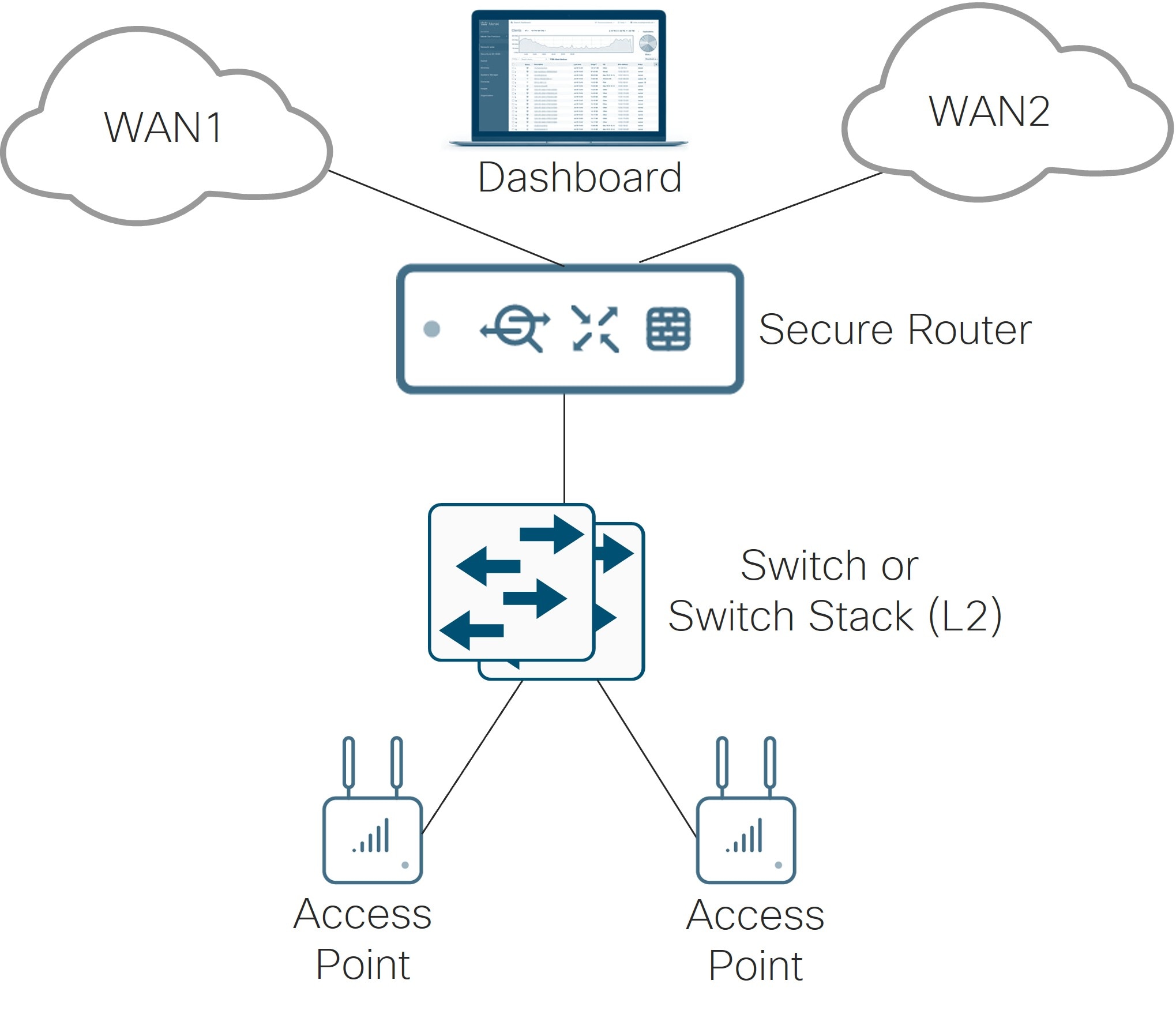
The following hardware components are part of the release I architecture. For the Catalyst switches (C9200/L, C9300/X/L), they must be able to run in cloud mode for full Meraki dashboard-delivered management. Cloud mode delivers a complete cloud management experience, supporting UI or API-driven configuration and optional, read-only CLI.
The Catalyst 9200/9300 switches can optionally be ordered with a SKU ending in -M. These models arrive in cloud mode and can be immediately onboarded to the dashboard. Any non-M versions need to be migrated to cloud mode. Cloud native IOS XE 17.15 and 17.18 have now been released, and cloud native images are the release of choice for cloud mode Catalyst devices moving forward. See Cloud Management with IOS XE Overview for more detailed information on SKU support, minimum versions for cloud management, and migration.
Note: The software minimum in the table below reflects the minimum software tested for Unified Branch Release I. The recommendation is to use the latest stable release version for each platform.
| Component |
Model Family |
Software Minimum |
License(s)** |
| Secure Router |
MX 18 |
Advantage Subscription |
|
| Access Switch |
CS 17/IOS XE 17.15 or 17.18 depending on the model |
Advantage Subscription |
|
| Access Switch |
IOS XE 17.15 or 17.18, depending on the model |
Advantage Subscription |
|
| Access Switch |
MS 17.1.4 |
Advantage Subscription |
|
| Wireless LAN Access Points |
MR 31 |
Advantage Subscription |
*Base MX67/MX68 (non-W/CW versions)
**For more information on subscription licensing, refer to Subscription – Licensing Overview.
Check each model family’s data sheet in the table above for stack cabling SKUs for switch stacking use cases.
The network devices require onboarding to the dashboard to be properly managed. Before attempting to onboard a device to the dashboard, ensure all the dashboard pre-requisites are met. This includes claiming devices, adding licenses, and configuring networks. Refer to the Getting Started Checklist for additional information.
Unified Branch Secure Router
Unified Branch Release 1 supports an MX67, MX68, MX85, MX95, or MX105 secure router. Check the individual datasheets in the table above for information for specifics on interface types, performance capabilities, physical characteristics, power requirements, Power over Ethernet (PoE) capabilities, etc.

Deployment Mode
The secure WAN router can be deployed in either Routed (default) or Passthrough/VPN Concentrator mode. For this design, routed mode is enabled for the branch router.
In routed mode, the WAN router acts as a layer 3 gateway for subnets configured on the LAN side, and routes encrypted traffic over the auto VPN overlay to other sites or Internet traffic out the WAN uplinks to the Internet. Client traffic to the Internet is translated using NAT overload so its source IP address is the uplink IP address of the WAN router uplink. This mode is best if layer 3 networking capabilities are required and the WAN router is connecting directly to your Internet demarcation point with a public IP address issued by the Service Provider. Routed mode is the most common branch deployment model.
WAN Connectivity
The MX67/68 has 2 ports that can be used for WAN connectivity. The MX68 has 2 dedicated WAN ports and the M67 has one dedicated WAN port, but port 2 (LAN port) can be converted to a WAN port for the second uplink.
| Secure Router |
WAN Interfaces |
Port Numbers |
| MX67 |
1x dedicated 1 Gigabit Ethernet RJ45 |
Port 1 |
| MX68 |
2x dedicated 1 Gigabit Ethernet RJ45 |
Ports 1-2 |
The MX85/95/105 has 4 total possible ports that can be used for WAN connectivity, which are represented in the following table.
| Secure Router |
WAN Interfaces |
Port Pairing |
| MX85 |
2x dedicated 1 Gigabit Ethernet SFP |
Port 1 (SFP) – Port 3 (RJ45) |
| MX95/MX105 |
2x dedicated 10 Gigabit Ethernet SFP+ |
Port 1 (SFP) – Port 3 (RJ45) |
The MX in release I has two active uplink (WAN) interfaces. If an SFP is detected at device boot for port 1 or 2, then that port is enabled, and its RJ45 port pair partner is disabled (port 3 or 4). If an SFP is not detected at device boot for port 1 or 2, then that port is disabled, and its RJ45 port pair partner is enabled (port 3 or 4). Port preference is retained until the next boot, even if an SFP is removed during device operation. Port selection can also be configured through the device’s local status page and not through the main dashboard.

Port 4 on each model supports PoE+, which could be used to support any WAN gateway device, such as a cellular gateway, or satellite or cable modem. For more information, see the WAN Behavior on MX75/85/95/105 document.
Device Onboarding
By default, the MX WAN ports are set to receive their IP address, IP gateway, and DNS information through DHCP from the WAN Service Provider (SP). Once this information is obtained, the router can connect to the dashboard on the Internet for software upgrade, monitoring, and configuration. The WAN interface parameters (static IP address and mask, gateway IP address, and primary/secondary DNS) can also be configured through the device’s local status page if needed for connectivity to the provider. These parameters can also be changed through the dashboard once the device is connected.
WAN Uplink Dashboard Reachability Preference
By default, the first WAN interface on the MX router is chosen as the primary WAN interface to establish connectivity to the cloud dashboard when both WAN links are active. If the first link is down, then the second WAN uplink will attempt to connect to the cloud dashboard. The Primary WAN uplink is configurable under the dashboard settings. This link is also the default interface for routed VPN and Internet traffic in the absence of traffic steering policies or Internet traffic load balancing configuration.
LAN Connectivity
The MX85 and MX68 have 10 possible ports that can be used for LAN connectivity, while the MX95/105 has 6. The MX67 has 4 possible ports that can be used for LAN connectivity, although one port (port 2) can be converted into a WAN port. The LAN interfaces are represented in the following table.
| Secure Router |
LAN Interfaces |
Port Numbers |
| MX67 |
3x dedicated 1 Gigabit Ethernet RJ45 |
Ports 3-5 |
| MX68 |
8 dedicated 1 Gigabit Ethernet RJ45 |
Ports 3 -10 |
| MX85 |
8x dedicated 1 Gigabit Ethernet RJ45 |
Ports 5-12 |
| MX95/MX105 |
4x dedicated 1 Gigabit Ethernet RJ45 |
Ports 5-8 |
The MX router by default is configured for single VLAN (untagged VLAN 1) operation, which is called Single LAN mode. All LAN ports are placed into VLAN 1 and a VLAN 1 layer-3 interface is configured with an IPv4 subnet of 192.168.128.0/24, along with a DHCP server configuration and DHCP pool of addresses in the range of 192.168.128.2 - .254. The purpose of the DHCP pool is to hand out IPv4 addresses to downstream LAN devices (switches, APs, etc.), allowing them to be quickly and easily onboarded to the dashboard.
When VLAN mode is configured, several VLANs are defined along with their respective layer 3 interface IP addresses that act as IP gateways for downstream clients. When VLAN mode is set for the first time, the Single LAN IP address appears under VLAN 1 (named Default) This VLAN also inherits the DHCP server configuration and DHCP pool for devices in VLAN 1 that request DHCP services.
By default, all MX ports are enabled and defined as 802.1Q trunks, allowing all VLANs with VLAN 1 as the native/untagged VLAN. In this design, the link to the switch is left as the default trunk, and all unused ports are disabled to reduce security risks.
In the small branch design, 5 additional VLAN interfaces are defined in addition to the default VLAN 1, including DATA (VLAN 10), VOICE (VLAN 20), IOT (VLAN 30), GUEST (VLAN 50), and INFRA (VLAN 999).
Downstream Device Dashboard Onboarding
When a downstream, connected cloud-managed switch is booted for the first time, all its switch ports default to trunk ports with the native/untagged VLAN defined as 1. The switch initiates an untagged DHCP request on all connected interfaces and receives an IPv4 address in the 192.168.128.2 - .254 address range and gateway address (192.168.128.1) from the MX router. Likewise, when a downstream cloud-managed wireless AP is connected to the switch and initially booted, the AP initiates an untagged DHCP request for an IP address from the same DHCP pool and gateway on its uplink port. The MX router firewall is, by default, configured to allow all outbound traffic to the Internet initiated internally on VLAN 1, and it NATs the traffic to the IP address of the WAN interface. This allows any downstream devices to connect to the dashboard.
Management VLAN
When downstream devices are onboarded by default, their internal management connections are untagged on VLAN 1 and end up sourced with an IP address from the 192.168.128.0/24 pool. This same pool is used as the default for all MX routers in all branches. This allows the devices to connect to the dashboard through the MX’s Internet uplink, but if the device needs to access shared services in the data center such as radius, DNS, and other services, then a unique subnet needs to be used instead at each branch for these infrastructure devices.
Switches and access points by default try to contact the dashboard on the untagged VLAN, but alternatively, a tagged VLAN can be used under the device configuration settings. In this design, a separate VLAN 999 is created called INFRA and the management control traffic is tagged for that VLAN. Once a device is onboarded to VLAN 1 and connected to the dashboard, it can pull its configuration from the dashboard, to begin tagging its control traffic with VLAN 999. VLAN 999 uses a unique subnet per branch.
To reach the shared services in the data center, the MX router uses the highest VLAN defined and sources the traffic from its IP address in that subnet, which is why VLAN 999 is chosen (so all devices source their management control traffic from the same VLAN). Use the highest VLAN for device management traffic if all devices should use a management IP address from the same subnet.
Unified Branch Switch
Unified Branch release I supports MS150, MS130, C9200/L, C9300/X/L and -M models of switches to provide LAN connectivity to devices within the small branch. Check the individual datasheets for information for specifics on interface types, performance capabilities, physical characteristics, power requirements, Power over Ethernet (PoE) capabilities, etc.

Power over Ethernet (PoE)
Support for PoE on switch ports may be needed when connecting wireless LAN (WLAN) APs, IP phones, surveillance cameras, and other devices to the switch.
Several of the MS, C9200, and C9300 models support 802.3at / PoE+ (Type 2) which can supply up to 30W per port up to the total power budget for PoE devices of the switch. Several C9300-M models also support 802.3bt / UPOE (Type 3) which can supply up to 60W per port up to the total power budget for PoE devices of the switch. A few MS models can also support UPOE on a subset of their ports. The total power budget for PoE devices depends on the number of power supplies installed within the switch, as well as the power rating of the individual power supplies (715 Watts AC vs. 1100 Watts AC, etc.). Check the individual data sheets for more details. The Cisco Power Calculator can also be leveraged to determine PoE power consumption for select Cisco models.
Uplink Connectivity to Switch
By default, the switch port uplink connecting to the MX device is configured as an 802.1Q trunk port allowing all VLANs with VLAN 1 being the native/untagged VLAN. While unused VLANs can be pruned off the trunk, if VLANs are added or changed, extra configuration steps are required to add/change VLANs on the trunks. Also, an unused VLAN can be configured as the native/untagged VLAN for additional security hardening. In this design, all VLANs are allowed on the trunk to keep configurations simple, and VLAN 1 remains the native/untagged VLAN. VLAN 1 is used as initial onboarding for any new devices added to the network and has access only to the Internet (for dashboard connectivity). Once a device configuration is downloaded, devices use the INFRA tagged VLAN 999 for management traffic.
The link speed (10 Mbps, 100 Mbps, 1 Gbps, and/or 10 Gbps) and duplex (full or half) of the Ethernet ports on the MX router and the switch must match for the uplink to come up active. A best practice is to leave the link speed for auto-negotiation of speed and duplex.
Unified Branch WLAN Access Points
Unified Branch release I supports C9172 and C9176 models of Access Points (APs) to provide wireless LAN (WLAN) connectivity within the branch. Check the individual data sheets for information for specifics on capabilities, power requirements, etc.
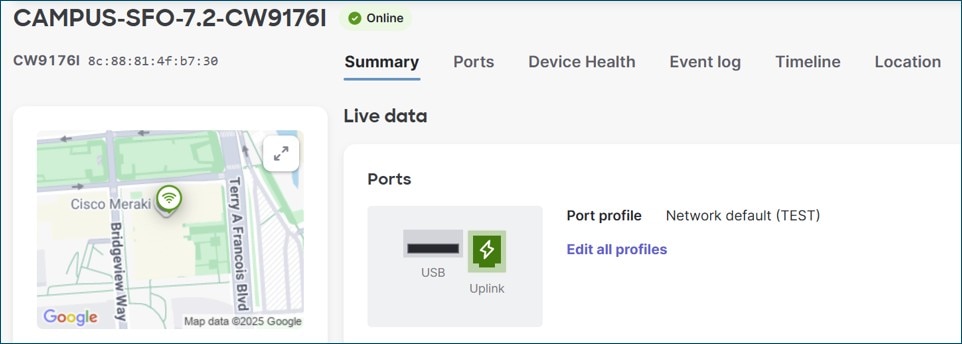
Uplink Connectivity to the Switch
The CW9176 and CW9172 APs support a single uplink port for connectivity to the switch. By default, the AP uplink connecting to the switch is configured as an 802.1Q trunk port allowing all VLANs with VLAN 1 being the native/untagged VLAN. As mentioned previously, VLAN 1 is the default/untagged VLAN to ensure downstream switches and APs can initially connect to the dashboard to onboard, but the device management is moved into the tagged INFRA VLAN 999 once configurations are downloaded. Since the AP will service both corporate and guest users in different VLANs, the connection between the AP and switch should be configured as a trunk port. In this design, the default trunk configuration settings are used for simplicity.
As with the uplink between the MX router and the switch port, link speed and duplex (full or half) of the Ethernet ports on the switch and the AP must match for the uplink to come up active. Again, a best practice is to typically leave the link speed for auto-negotiation of speed and duplex.
| Access Point Model |
LAN Uplink Interfaces |
| 1x 100M/1G/2.5G BASE-T Ethernet (RJ45) |
|
| 1x 100M / 1G / 2.5G / 5G / 10G BASE-T Ethernet (RJ45) |
PoE Requirements for Access Points
When configuring the uplink between the switch and APs, the network administrator needs to consider how power is to be supplied to the APs. Power can be supplied via a switch that supports PoE and supplies the necessary power (in terms of Watts) required for the AP model, or through an external device such as a power supply or inline PoE injector. To ensure the power is sufficient to power the AP, check the individual AP data sheets for minimum and maximum power requirements.
Throughput requirements
The aggregate throughput requirements of each AP within a small branch site should be determined based on the number of clients and each client’s application requirements and traffic expectations and ensure that uplink speeds to the switch are adequate and can accommodate for future growth.
Unified Branch Services
Multiple services are included in Unified Branch Release I, such as WAN services, wired LAN services, wireless LAN services, security services, and network management services.
WAN Services
Secure WAN services are implemented by the MX router. This includes Software-defined WAN (SD-WAN) and its features, such as secure WAN connectivity, LAN to WAN routing, and traffic shaping.
Software-defined WAN (SD-WAN) is a set of features that enables networks to automatically adapt to changing WAN conditions without manual intervention, ensuring optimal performance for critical applications and minimizing disruptions for sensitive traffic like VoIP. It also offers secure, granular traffic control and is often a more scalable and cost-effective solution compared to traditional WAN circuits such as MPLS. SD-WAN makes use of the Auto VPN feature, which is a proprietary technology that facilitates route advertisements and allows VPN tunnels to be easily built between WAN routers in the network branches.
WAN Connectivity
WAN connectivity refers to the wide area network’s topology and how the router connects to it. The router in a branch typically connects directly to the service provider, obtains a dynamic IP address by default, and receives a gateway address and DNS server address through DHCP. Traffic from the branch router is sent towards the service provider to connect to the dashboard, to route Internet traffic, or to route encrypted VPN tunnel traffic to another branch site. Note that IP addresses, gateways, and DNS server addresses can also be statically defined as an alternative to DHCP.
This design uses DHCP on both transports to obtain IP addresses, gateways, and DNS server addresses.
WAN Topology
A WAN topology refers to the different ways that a Wide Area Network can connect to multiple locations, such as full mesh, hub-and-spoke, and partial mesh. Unified Branch release I implements the hub-and-spoke topology, where all branch sites (spokes) set up direct VPN tunnels to a central hub or multiple hubs.
A hub is defined as a central site, such as headquarter locations, data centers, and large campuses that is hosted near resources and services that other locations need to access. Hubs also set up direct VPN tunnels to other hubs. All spoke-to-spoke communication must traverse the hub.
This model simplifies management and traffic flow and is cost-effective because only hubs need to have the capacity to scale the number of VPN tunnels required. However, it introduces additional latency as all traffic must pass through the hub, which could also become a congestion point if not properly designed. For proper redundancy, ensure that more than one hub is defined.
When configuring spokes in a hub-and-spoke VPN topology, the spokes must have the hubs explicitly listed or configured as peers to establish tunnels. Before hubs can be chosen in the drop-down menu in the spoke configuration, they must have first been defined as a hub in their own configuration. In what order the hub is listed determines the hub priority for that spoke. When a route is available through multiple hubs, the spoke routes to the hub highest on the list.
In this design, two hubs are defined with DC1 as primary and DC2 as backup.
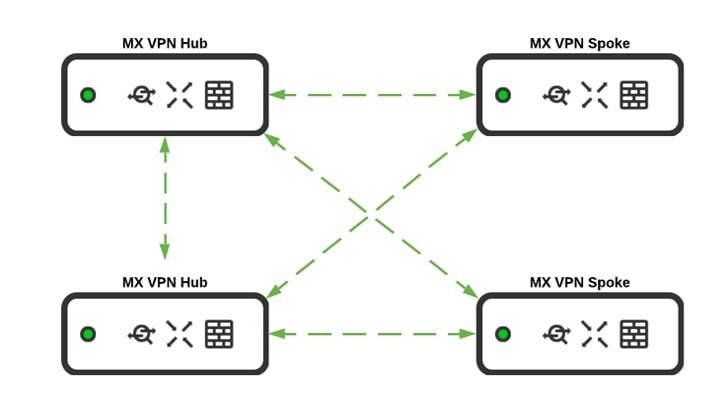
Auto VPN
Auto VPN is a proprietary technology that automatically builds encrypted VPN tunnels between WAN routers in the network branches. The main mechanism that allows Auto VPN to happen is the VPN registry, which is a cloud service that keeps track of contact information for the WAN routers participating in Auto VPN for an organization. Routing across the secured WAN leverages the contact information found in the VPN registry. It is important that certain IP addresses and ports are open on any upstream firewalls so WAN routers can reach the VPN registry. See Auto VPN Configuration and Troubleshooting for more information.
Dual WAN
In Unified Branch release I, dual WAN transports are implemented, both of which have connectivity to the dashboard. Dual WAN uplink provisioning to separate service providers is a general best practice for resiliency purposes so when a connection to one transport or provider fails, there is still connectivity for traffic through the opposite transport or provider. Connection monitoring is performed on each WAN uplink interface once carrier is detected and an IP address is assigned (static or dynamic), which can determine the health of the uplink and Internet connectivity and determine when failover needs to take place. See the Connection Monitoring Test Process page for more information.
By default, control connectivity to the dashboard leverages the first WAN (WAN 1) but will leverage the second WAN (WAN 2) if the first WAN uplink connectivity fails. The primary WAN uplink can be configured through the dashboard and is also the default interface for routed VPN and Internet traffic in the absence of traffic steering policies or Internet traffic load balancing configuration.
With dual uplink solutions, VPN tunnels can run over both available uplinks or when the primary link fails. This design utilizes VPN tunnels over both uplinks.
Dual WAN can be implemented as active/standby or active/active. With active/standby, all traffic (VPN and Internet) is directed out WAN 1 and falls back to WAN 2 when WAN 1 fails. With active/active, both uplinks are available for traffic forwarding. In active/active mode, Internet traffic and VPN traffic can use traffic steering to direct some traffic out one link or the other, but there is also the ability to load-balance Internet traffic.
This design implements dual WAN as active/active. Some VPN and Internet traffic is directed out of the second WAN transport with traffic steering policies, and all other traffic is directed out of the first WAN transport by default.
With load balancing, Internet-bound traffic flows are distributed between the two uplinks. How the load is distributed between the WAN 1 and WAN 2 links depends on the bandwidth configured under the Uplink configuration. The link with the higher configured bandwidth distributes more flows. Note that load balancing is based on flows considering source and destination IP and port and will attempt to round-robin connections on both WAN uplinks.
Note that some applications spawn off multiple sessions for a single use session which could get load-balanced to the opposite WAN uplinks with different NAT addressing. This can cause application failures. Disable load-balancing in those cases and use traffic steering policies to distribute traffic to the WAN uplinks.
This design does not implement load-balancing for Internet-bound traffic.
LAN to WAN Routing
Auto VPN through the VPN registry populates the routing table of subnets which belong to other sites. For a VLAN subnet to be advertised, its VPN mode setting is set to Enabled in the dashboard configuration. For VLAN subnets that should not be advertised, their VPN mode setting is set to Disabled (the default). In this design, the default VLAN 1 and Guest VLAN 50 subnets are set to disabled, while all other VLANs are set to enabled.
When client traffic needs to be routed, the routing table is consulted for the destination for the longest-match prefix. If the route exists in the table, then the traffic is routed according to the next hop. The route could be a connected or static route, client VPN and other VPN peer route, Auto VPN route (where traffic will be directed over the VPN tunnel to a particular site), or BGP-learned route. Given the same route, one route type is selected depending on the priority. See the MX Routing Behavior document for more information. Connected, static, and Auto VPN routes are supported in Unified Branch release I.
If a specific Auto VPN route has multiple next hops to its hubs after the longest-match prefix is selected, then the router will choose to route to the hub with the highest priority. This priority is established through the order in which the hubs are defined on the spoke’s Site-to-site VPN page on the dashboard.
Default Route Advertisement
There are multiple ways for default routes to be defined for an MX router. By default, default routes are always installed using the WAN uplinks as the next hop out to the Internet. If no other default routes are defined, traffic will take the default route directly to the Internet if it doesn’t match a route in the Auto VPN overlay.
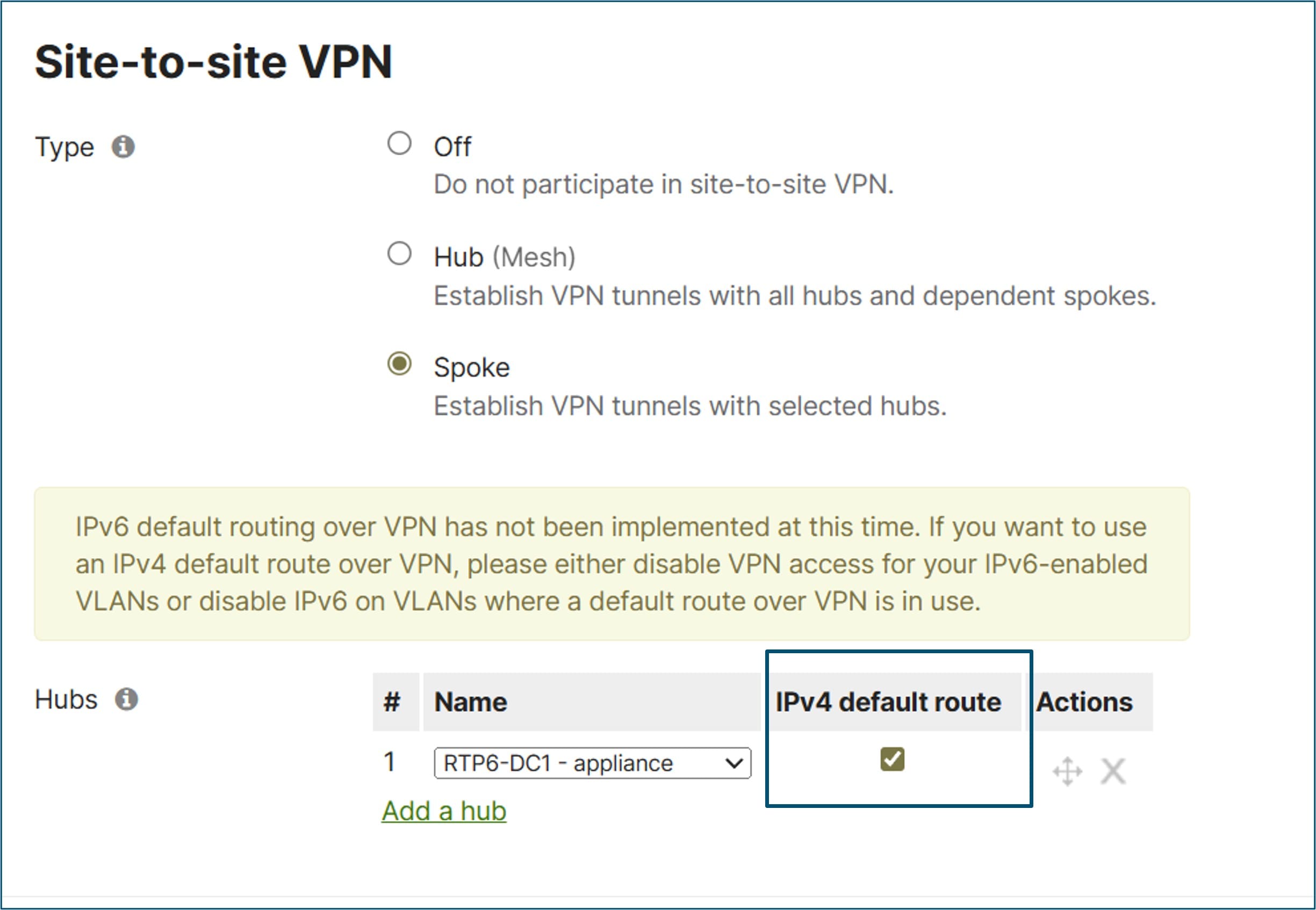
A default route can also be configured from a hub when the hub is defined on the spoke’s Site-to-site VPN configuration page. Next to the hub definition, an IPv4 default route box can be checked. This default route takes precedence over an uplink default route. This means that all traffic not matching other VPN routes, which includes Internet traffic, takes the overlay to the hub advertising the default route and is routed from there. If multiple hubs advertise the default route, then the router will choose to route to the hub with the highest priority.
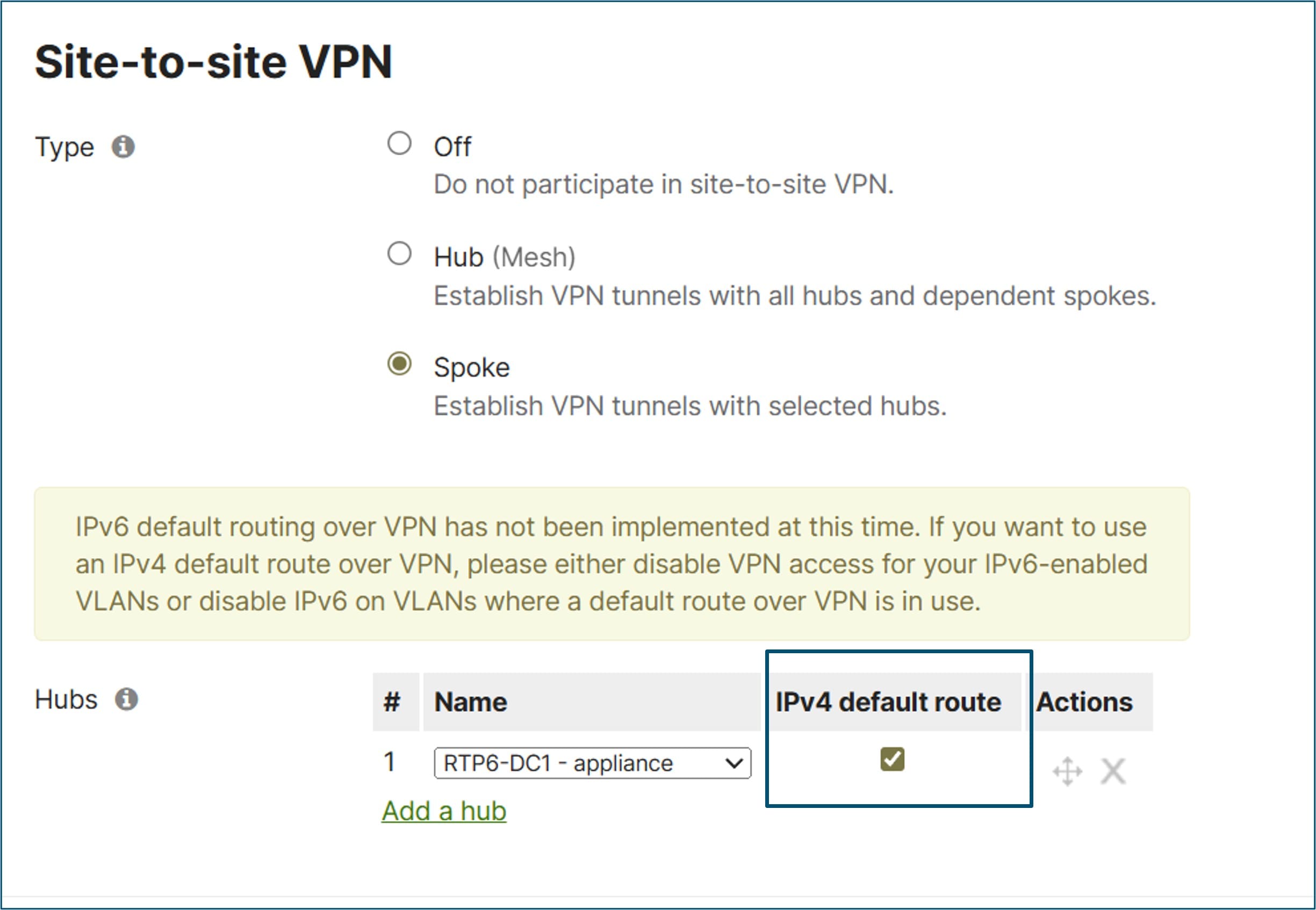
Another way to advertise a default route from the hub is to add a static default route and enable it for VPN mode or advertise it from the hub through BGP.
The routing table on the branch router can be viewed under Monitor>Route Table on the dashboard.
In this design, default routes are advertised from each hub using the IPv4 default route configuration on the spoke’s Site-to-site VPN configuration page.
Direct Internet Access (Local Internet Breakout)
By default, if there are no default routes advertised from the hub sites, traffic can be sent out direct Internet access (DIA) from the branch using the WAN uplink if there are no matches to routes already in the routing table. When a default route is advertised from the hub sites, this puts the branch in full tunnel mode which means all traffic is now tunneled, including Internet traffic. The exception to this is for any VLAN subnet with VPN mode disabled, which means the subnet is not advertised across the Auto VPN. This traffic is also not transmitted across the VPN and can only be transmitted out the direct Internet uplink, unless prohibited by firewall rules.
If direct Internet access is needed while in full tunnel mode, VPN exclusions must be configured. This allows the administrator to configure layer-3 and some layer-7 destination rules to determine exceptions to the full tunnel VPN configuration, allowing some traffic to go out to the Internet directly.
DIA improves the user experience since it eliminates any performance degradation related to backhauling Internet traffic to a centralized data center.
In this design, some SaaS traffic for corporate users and dashboard traffic for downstream switch and AP devices leverage VPN exclusions.
SD-WAN Traffic Policies
SD-WAN traffic policies match traffic and steer traffic to a particular uplink and failover to the opposite uplink should the preferred one fail or if SLAs are not met for performance. Rule definitions for classifying/matching traffic are based on L3 characteristics (source and/or destination IP address and/or port) or L7 characteristics (application and/or application category). If a policy is contingent on performance, it references a previously configured performance class. Performance classes are configured to define the max loss, latency, and jitter a traffic class can tolerate. SD-WAN policies are defined separately for Internet and VPN traffic.
For VPN traffic, performance probes (UDP data of approximately 100 bytes) are sent every second and are used to determine loss, latency, and jitter over each Auto VPN tunnel. For Internet data, uplink statistics are gathered. The default target is 8.8.8.8 (Google DNS), but it can be modified from the dashboard under Security & SD-WAN>Configure>SD-WAN & traffic shaping>Uplink configuration>Uplink statistics.
Note that all traffic not matching a defined policy is routed to the default WAN uplink until it is declared down, regardless of loss, latency, or jitter. It is recommended to define a default traffic policy with a default performance class to catch all other traffic not already specified in policy to avoid traffic being transported across a poor-performing tunnel.
In this design, both Internet traffic and VPN traffic steering policies were created. Custom performance classes were defined for SaaS traffic, critical application traffic, and default VPN traffic.
WAN Traffic Shaping
On the MX router, uplink bandwidth settings, both upload and download bandwidth, can be set. These values are used for rate-limiting all traffic in and out through each WAN port. This is used when the contracted bandwidth for the WAN service (the sub-line rate) is less than the physical bandwidth of the connection. Bandwidth limits can even be set on each client device’s total incoming/outgoing traffic.
There are also shaping polices that can be applied on a per user per-application basis. Applications or custom expressions (CIDR/IP ranges, ports, local networks, etc.) can be used to match traffic, then bandwidth limits (optionally), priority, and DSCP tags can be assigned. Priorities can be set to High, Normal, or Low and allow the MX router to prioritize a given network flow relative to the rest of the network traffic. Expedited Forwarding traffic (DSCP 46) is given highest priority. Default shaping rules can be used with additional rules added, or rules can be completely customized.
For more information, see the SD-WAN and Traffic Shaping document.
In this design, uplink bandwidth setting examples are provided. Also, default shaping rules are used with additional rule examples for guest and critical application traffic.
Wired LAN Services
Some wired LAN services are implemented by the MX router, some by the switch, and some by both. These services include LAN connectivity, Link Layer Discovery Protocol (LLDP), VLAN segmentation, Spanning Tree Protocol, STP Guard, storm control, access policies, shared services VLAN, LAN Routing, DHCP, and LAN Switch QoS (ingress classification, marking, and queuing).
LAN Connectivity
For LAN connectivity, there are 802.1Q trunks between the MX router, switches, and access points to carry VLAN-tagged traffic as well as native/untagged VLAN 1 traffic. Ports on the network devices are set to auto-negotiate port speed and duplex as a general best practice unless there is a specific reason otherwise.
Link Layer Discovery Protocol (LLDP)
LLDP is a layer-2 protocol that automatically discovers connected devices. It is used to identify devices and their capabilities on the network, inform VoIP devices of the voice tagged VLAN, and negotiate PoE needs. LLDP is turned on by default.
VLAN Segmentation
VLAN segmentation provides a way to partition the network into different broadcast domains, each with a separate subnet. Data packets can be tagged with a VLAN identifier (VLAN ID) and switches can use tags to only forward between ports that share the same VLAN ID. Access ports assign incoming untagged traffic to a VLAN based on the port configuration, and trunk ports can carry all tagged VLAN traffic, as well as untagged traffic that is assigned to the native VLAN defined on the trunk. To communicate with devices in other VLANs, traffic needs to be forwarded to a layer-3 device that can route between VLANs.
The router provides the layer 3 termination point (SVIs) for multiple network VLANs, and by default, allows routing between those VLANs. In this design, the router is configured for six different VLANs: Default (VLAN 1), Data (VLAN 10), Voice (VLAN 20), IOT (VLAN 30), Guest (VLAN 50) and INFRA (VLAN 999). VLANs 10, 20, 30, 50, and 999 are carried on the trunk port between the router and switch, and VLAN 1 is the native or default VLAN for any untagged traffic coming in.
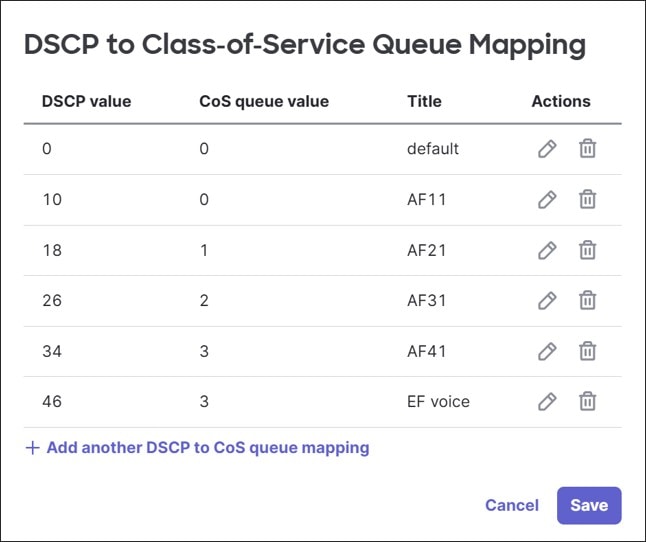
To prevent inter-VLAN communication, firewall rules can be added on the MX. To prevent subnets from being advertised and traffic from being routed across the VPN network, subnets are Disabled for VPN mode in the dashboard. For example, the Guest and Default subnets are Disabled as their traffic should not traverse the VPN tunnel network. It is assumed that the Guest and Default VLAN traffic will have direct Internet access only and may be further restricted based on security policies implemented on the MX. The rest of the subnets are Enabled for VPN mode and advertised to other WAN routers through the VPN registry.
Spanning Tree Protocol
Spanning tree is a network protocol designed for Ethernet networks to prevent bridge loops and broadcast storms that result from them. It operates at layer 2 (the Data Link Layer) of the OSI model. Rapid Spanning Tree Protocol (RSTP) is an enhanced version of the original protocol, providing faster convergence times after network topology changes or link failures.
On the switches, RSTP is enabled by default and will be active on all switches in the current network. Access ports on link up will bypass the learning state and immediately go into a forwarding state. It is critical that spanning-tree remains enabled to protect from unintended loops in the network. It’s also best practice to choose and configure the root switch and backup root switches, which are typically in the core or distribution layers. In the small branch, the single switch or switch stack can be configured with a bridge priority of 4096 to make it the root switch or switch stack. Using 4096 as the bridge priority instead of 0 provides flexibility to make temporary modifications to the root bridge if necessary. The default bridge priority is 32768. Once RSTP is enabled globally, it is enabled at the port level by default. It is recommended that RSTP be enabled on all ports. It is important to note that the MX router does not run spanning tree and will not exchange BPDUs with other switches nor participate in the root bridge election process. If the MX router receives BPDUs on the LAN, these BPDUs are re-forwarded to other ports within the same VLAN, or broadcast domain.
In this design, RSTP is enabled, and the switch/switch stack is configured to be the root switch/switch stack with a priority of 4096.
STP Guard
STP guard is a configuration option under the switch port or switch port profile. Settings include Disabled, Root guard, BPDU guard, or Loop guard. STP Guard is disabled by default.
For the single switch/switch stack design, only BPDU guard is applicable. This configuration protects the spanning tree topology by enforcing the STP domain borders. The port moves into a disabled state if it receives a BPDU. This should be applied to all ports or ports connected to clients. Do not apply to the uplink port connecting the switch to the router.
In this design, BPDU guard is applied to all ports except the port connecting to the MX.
Unidirectional Link Detection (UDLD)
UDLD detects and acts on logical one-way links to prevent forwarding loops and blackholing of traffic. It is supported on switches and configured under a port or port profile. The Alert only setting (default) generates an alert if UDLD detects one-way traffic. The Enforce setting blocks network traffic if UDLD detects one-way traffic. Enforce is recommended to be used on point-to-point links between switches.
This design uses the Alert only setting for UDLD on all ports.
Storm Control
Storm control is designed to prevent network performance degradation caused by a network storm of excessive broadcast or multicast traffic. It can be enabled on switches to suppress broadcast, multicast, and unknown unicast packets based on a traffic percentage on an interface. Each category of traffic bandwidth is monitored on each switch port every second. Traffic that exceeds the defined limit is dropped.
To set the percentage of broadcast, multicast, and unknown unicast traffic, the administrator needs to understand what the normal level of broadcast, multicast, and unknown unicast traffic is in the network. This will vary from network to network and may depend on the day of the week and even the time of day.
In this design, an example storm control policy is created.
Access Policies for Port Access
Access policies can be configured on the switch, which require authentication from a RADIUS server before network access is granted. These are commonly configured on access-layer switch ports to prevent unauthorized devices or users from connecting to the network. RADIUS servers can pass back dynamic VLAN information the client belongs to and well as other information, and the client can then obtain IP address information through DHCP.
The Radius server can be the built-in radius server from the dashboard or a standalone server in the network.
There are three access policy types:
● 802.1x: Clients that connect are prompted for their credentials. If credentials are valid, their device can be granted access to the network.
● MAC Authentication Bypass (MAB): When MAB is enabled, the client’s MAC address is authenticated against a RADIUS server. If the server determines the MAC address is a valid credential, the device will be allowed access.
● Hybrid Authentication: With hybrid authentication, clients are prompted for their credentials for 802.1x authentication, but if the client doesn’t start 802.1x authentication then the client’s MAC address will be authenticated with the RADIUS server. Hybrid authentication is useful when not every device supports 802.1x authentication, however, MAB is less secure and more easily spoofed.
Host mode for 802.1x refers to how many clients can be authenticated and connected through a single port, and there are 4 different settings. Single-host allows only one client per port. Multi-host allows multiple clients, and one successful authentication grants access to all clients on that port. Multi-auth allows multiple clients but each authenticates separately. Multi-domain requires separate authentication for voice and data devices on the same port.
In this design, a RADIUS server in the data center is leveraged. The access policies are applied to client ports using hybrid authentication and set for single-host mode. No failed Auth VLANs are defined if authentication fails.
Shared Services VLAN
A shared services VLAN is designated to host network services that can be leveraged by other VLANs. Its purpose is to centralize, secure, and efficiently manage common network services that are utilized by other VLANs. In a local branch, a shared services VLAN might contain shared resources such as local printers or files servers that do not need to reside at a data center or central site. To allow certain traffic or restrict certain traffic to this VLAN locally, layer-3 and layer-7 firewall rules can be added to the MX router.
In the data center, shared services could be DHCP, DNS, RADIUS, syslog, NetFlow, etc. VLANs with devices that need to reach shared services in the data center need to have their VPN mode enabled so their subnet can be reachable from the data center. To allow certain traffic or restrict certain traffic across the Auto VPN overlay, site-to-site firewall rules can be added to the MX router.
This design doesn’t leverage a shared services VLAN but uses firewall rules to allow access to a subset of resources in a local branch VLAN and data center.
LAN Routing
In Unified Branch Release I, the MX router is configured for layer-3 routing with Switched Virtual Interfaces (SVIs), meaning the routing to the LAN is through the directly connected VLAN interfaces (connected routes). Static routing is also supported in this release. Static routes are used so traffic can be routed to other subnets reachable through another layer 3 device on the network. Each static route requires a next hop IP address defined that is included within the scope of a configured VLAN/subnet so traffic can be routed successfully. When a static route is added to the MX router, it can optionally be enabled for VPN mode so it can be advertised to other sites.
This design uses connected routes on the LAN.
Dynamic Host Configuration Protocol (DHCP)
DHCP is a network protocol used on IP networks and automates address assignment and other network configuration parameters to devices to allow them to communicate on the network. It reduces manual workload for network administrators, minimizes errors, and allows new devices to be added quickly or moved to other network segments without manual intervention.
In Unified Branch Release I, the MX router can act as a DHCP server, or it can forward DHCP messages to a centralized server, commonly located in a data center. As a DHCP server, lease time is configurable up to a week, boot options and DHCP options and DNS servers can be specified, and reserved ranges and fixed IP assignments can be configured. Mandatory DHCP is also configurable, and if enabled, client traffic without DHCP leases (ex. static IP addresses) will be dropped.
DHCP settings are set for each VLAN that has a layer-3 interface on the router.
In this design, the default VLAN, guest VLAN, and Infra VLAN use local DHCP services from the MX router, while the other VLANs get relayed by the MX to a DHCP server positioned in the data center. The default VLAN and guest VLAN receive OpenDNS IP addresses on the Internet to use for DNS, while the other VLANs receive DNS server information in the data center. For the Infra VLAN, fixed IP assignments are created for the switch and AP, so their IP addresses stay the same and no static IP address configuration is required for ease of operation.
LAN Switch Quality of Service (QoS)
QoS allows for prioritization of traffic in the network. It guarantees some fraction of the link to each configured priority level when there is congestion on the link. Higher priority queues receive more bandwidth than those in lower priority queues, but bandwidth can be used by other queues when there is no congestion.
Differentiated Services Code Point (DSCP) bits in the packet header inform switches what Class-of-service (CoS) queue should be used through a DSCP-to-CoS queue mapping policy table that can be modified.
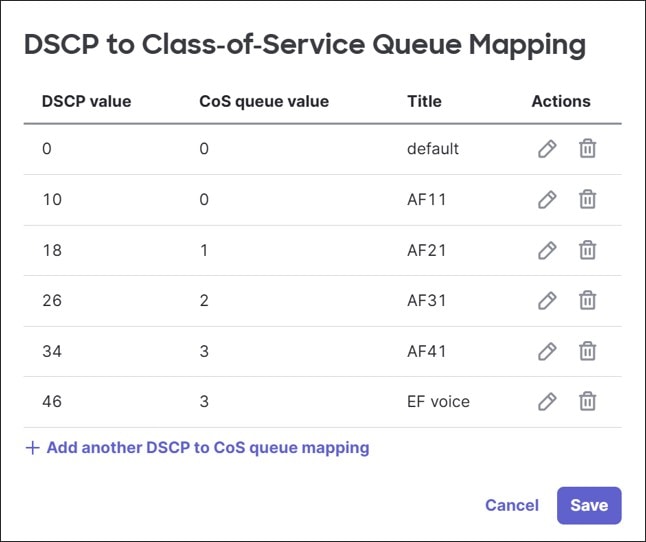
DSCP bits can be added, modified, or trusted for a particular packet. The switches use QoS network rules matching on VLAN, protocol, source port or destination port to define how to handle DSCP tagging of packets.
By default, DSCP tags are trusted and passed through unmodified, and default DSCP-to-CoS settings are used to determine what outgoing queue packets will use. An incoming packet with DSCP set that does not match a QoS rule will keep the DSCP setting, and if a packet’s DSCP does not match the DSCP-to-CoS mapping, it is placed into the default queue.
Note that Switch QoS settings are network-wide settings, so all switches sharing a network inherit the same settings. See MS Switch Quality of Service Defined for more information.
In this design, the DSCP-to-CoS mappings were kept at default. Guest traffic is set to untrusted and get assigned DSCP 0, while other traffic is set to trust DSCP values.
Wireless LAN Services
Wireless LAN (WLAN) services consist of configuration related to wireless LAN clients. The services consist of wireless connectivity, support for multiple SSIDs, guest services, RF profiles with radio resource management (Auto RF and AI-RRM), and wireless QoS.
Wireless Connectivity
Wireless LAN connectivity is provided through Wi-Fi 7 / 802.11be compliant CW9172 and/or CW9176 cloud-managed access points (APs) which function as gateways that bridge wireless LAN clients onto the wired LAN as well as provide connectivity between WLAN clients where desired. In bridge mode, wireless LAN clients receive IP addresses either from centralized DHCP servers or from DHCP pools defined on the MX router.
In this design, guest clients receive IP addresses from a local pool defined on the MX router, while the corporate clients receive IP addresses from a centralized DHCP server in the data center.
Multiple SSIDs
Multiple SSIDs can be configured to provide different services and levels of security within the branch deployment. For example, an SSID targeted for employee traffic can be configured 802.1X authentication using an external Radius server, operating in WPA3 transition mode.
In this mode, wireless clients that support both WPA3 - the latest Wi-Fi security protocol – can connect to the SSID using the 2.4, 5, or 6 GHz bands. Additionally, wireless clients that support only WPA2 can connect to the same SSID using only the 2.4 or 5 GHz bands.
Rather than provisioning multiple SSIDs for data, voice, and IoT devices, the Radius server can leverage group policy configured through the dashboard to assign the VLAN which the client traffic is to be terminated based on its identity, learned via username/password, digital certificate, or MAC address / MAB. This reduces the number of SSIDs broadcast within the branch.
Alternatively, for IoT devices, another SSID configured for pre-shared key (PSK) authentication, operating in WPA2 mode may be provisioned to alleviate the burden of maintaining MAC address lists.
In this design, one guest and one corporate SSID are configured. Within the corporate SSID, 802.1x authentication and WPA3 transition mode are enabled. After the client authenticates, a group policy name is passed back from the Radius server which references a VLAN to assign for the client traffic.
Note that Wi-Fi 7 cannot be enabled in the corporate SSID until per-group SSID configuration is supported because the guest SSID, which resides on the same AP, does not meet the security standards necessary. Per-group SSID configuration is available starting in MR release 32.1.4, where Wi-Fi 7-compliant SSIDs can co-exist on the same AP as non-Wi-Fi 7-compliant SSIDs as long as they are in separate SSID groups.
Guest Services
To support wireless guest services, a separate SSID may be provisioned within the branch. There are multiple methods for provisioning guest wireless access, from self-registration portals to requiring an internal sponsor within the organization. The most basic wireless guest access consists of an open SSID mapped to a VLAN, with a simple click-through splash page.
Guests may be allowed access to the Internet only, optionally with the ability to restrict the content to which they are allowed to access through the content filtering and next-gen firewall capabilities of the MX router. There is also a setting to enable layer-2 LAN isolation where clients can only communicate with their IP gateway and not to other clients within the SSID.
In this design, a separate guest SSD is provisioned using an open SSID mapped to a VLAN with a simple click-through splash page. Guests are allowed only access to the Internet with layer-2 isolation enabled.
SSID Availability
With this feature, the administrator can specify certain times of day that an SSID is available on a particular access point. Once enabled, an existing schedule template can be chosen, or a custom schedule can be created.
In this design, a custom schedule is created.
RF Profiles with Radio Resource Management (Auto RM and AI RRM)
The dashboard provides pre-configured RF profiles for ease of deployment. For release I of Unified Branch, only a single RF profile is needed for small branch designs. The Basic Indoor Profile can be used directly or copied first then modified as needed to meet the requirements of branch. The RF profile controls various settings including RF bands (2.4, 5, & 6 GHz) enabled within the branch - either on a per AP, or per SSID basis, minimum bit rate configurations - either on a per band or per SSID basis, minimum and maximum transmission power or the radios within each band, as well as channel width as well as channel assignments within each band, among other functions. Band steering is also an option which steers capable clients to use the higher frequencies to leave lower frequencies available for legacy clients. A best practice is to allow radio resource management (RRM) and AI-RRM to leverage the RF profile to optimize the RF environment for wireless client devices.
In this design, the corporate SSID is enabled for 2.4 GHz, 5 GHz, 6 GHz, as well as band steering. The guest SSID is enabled for 2.4 GHz and 5 GHz. Default settings were mostly chosen.
Wireless QoS
Cloud managed APs support per-user and per-SSID bandwidth shaping in the upstream and/or downstream direction. For SSIDs with employee traffic (such as the Corp SSID) there may be no need or desire to limit traffic. However, there may be a desire to limit traffic on the Guest SSID, so that it consumes only a certain amount of bandwidth on the wireless medium as well as on the Internet WAN connection. This can be accomplished through per-client and per-SSID bandwidth shaping configuration within the dashboard. Note that this can only be enforced on a per-AP basis.
In addition to bandwidth shaping, cloud-managed APs also support traffic shaping. Traffic shaping provides the ability to identify traffic based on custom rule definitions specifying HTTP hostnames, port number, IP address range, or combinations of IP address range and port; or based on pre-defined Layer 7 application categories. Once categorized, rule actions control shaping and/or prioritization of the traffic by allowing unlimited bandwidth usage (ignoring bandwidth shaping limits set for the SSID), obeying the SSID limits set for the SSID, or applying more restrictive limits than specified for the SSID. The cloud dashboard provides a default set of rules for ease of deployment, which can be enabled or disabled.
In terms of QoS classification & marking traffic, cloud-managed APs implement a default downstream mapping of DSCP value to 802.11 access categories found at the following URL: https://documentation.meraki.com/MR/Wi-Fi_Basics_and_Best_Practices/Wireless_QoS_and_Fast_Lane
In the upstream direction, QoS sent by the client is honored. The DSCP field within the traffic sent from the client is maintained on the Ethernet network.
In this design, both guest and corporate SSIDs leverage default shaping rules. Only guest traffic utilizes the per-client and per-SSID bandwidth limit settings.
Security Services
Security is already built into different layers of the branch and across multiple devices. This section specifically covers the next-generation firewall features of the MX router.
A traditional firewall provides basic security, NAT, and stateful rule-based inspection and filtering but lack application awareness and advanced features. Next-generation firewalls include advanced features such as deep-packet inspection, intrusion detection and prevention system (IDS/IPS), advanced malware protection (AMP), URL and other content filtering capabilities.
Firewall
Firewall rules apply to traffic passing through the firewall and not traffic that originates or terminates on the firewall itself. There are two different areas in the dashboard to configure firewall rules on the MX router:
● Site-to-site VPN firewall rules: These rules apply only to outbound site-to-site VPN traffic, and these rules apply at the organization level for all MX routers that enable site-to-site VPNs. By default, all traffic is permitted from site-to-site. Rules can be configured for UDP, TCP, or ICMP protocols, source and destination subnets and source and destination port numbers if needed. Objects and object groups can be configured in lieu of source and destination subnets for ease of use.
In this design, site-to-site VPN firewall rules are used to permit access to shared services in the data center and prevent access to other VLANs across the auto VPN fabric.
● Layer 3 and Layer 7 firewall rules: Layer 3 rules are stateful and apply to direct Internet traffic as well as inter-VLAN traffic on a specific MX router. In NAT/routed mode, traffic is allowed outbound by default, and no traffic is allowed inbound except for ICMP directed to the MX router. To allow additional inbound traffic, NAT rules should be modified, and inbound rules to explicitly allow the traffic on inbound need to be configured. Outbound Layer 3 rules can be created for outbound Internet traffic and Inter-VLAN traffic. Rules can be configured for UDP, TCP, or ICMP protocols, source and destination subnets or VLANs and source and destination port numbers if needed. Objects and object groups can be configured in lieu of source and destination subnets for ease of use.
Layer 7 firewall rules are stateless and allow traffic to be blocked by application or application category, HTTP hostname, port and/or remote IP range. Geo IP-based rules can also be created, where traffic can be blocked based on country. If traffic is permitted by the layer 3 firewall, it is evaluated by the layer 7 firewall rules before being permitted. Layer 7 rules apply to VPN site-to-site traffic as well as direct Internet and inter-VLAN traffic, unlike Layer 3 rules, which do not apply to VPN site-to-site traffic.
In this design, layer 3 rules are created to allow local shared services access, allow direct Internet access for some VLANs, and deny access between VLANs. No layer 7 rules were created.
Intrusion Detection and Prevention System (IDS/IPS)
The IDS/IPS is designed to detect and prevent cyber attacks by monitoring the network for malicious activity. It analyzes network packets and matches them against rulesets for known and emerging threats, such as viruses, worms, and other threats. The rulesets are curated by Talos, and the cloud will automatically keep the ruleset up-to-date.
IDS/IPS inspects all traffic between the LAN and Internet and all traffic between VLANs, but not traffic within the same VLAN. The mode can be set to Disabled, Detection, or Prevention. With prevention, traffic is automatically blocked by best effort if it is detected as malicious based on the detection ruleset. It is recommended to enable IDS/IPS services. The ruleset can be set as Connectivity, Balanced, or Security, with Balanced being the default as it offers a compromise between security and performance. Select traffic categories and IP addresses/subnets can be configured to be bypassed when IDS/IPS or AMP is enabled (Trusted Traffic Exclusions). See Threat Protection for additional information.
In this design, intrusion prevention is enabled using the balanced ruleset and no traffic exclusions.
Advanced Malware Prevention (AMP)
AMP is an anti-malware technology which inspects HTTP file downloads and blocks or allows file downloads based on threat intelligence retrieved from the AMP cloud. It can be enabled or disabled and files and URLs can be specified in an allow list. It is recommended to have AMP enabled. Select traffic categories and IP addresses/subnets can be configured to be bypassed when IDS/IPS or AMP is enabled (Trusted Traffic Exclusions). See Advanced Malware Protection (AMP) for more information.
In this design, AMP is enabled with no traffic exclusions.
Content Filtering
Content filtering works by classifying URLs based on threat categories and web content curated by Talos. The router inspects the URL in the HTTP payload or the Server Name Indication field of the outbound TLS traffic. The records are used to query Talos for possible matches. Content filtering can only block domains when TLS/HTTPs is used. In the configuration, content and threat categories can be blocked, URL lists can be allowed or blocked, web searches can be blocked, and YouTube content can be restricted. See Content Filtering for more information.
In this design, several content and threat categories are blocked, along with an example URL.
Network Management Services
Network management services that are included in Unified Branch Release I are SNMP, Syslog, and NetFlow.
Simple Network Management Protocol (SNMP)
SNMP can be used for network configuration (SNMP queries) and/or for network monitoring (SNMP polling/queries or SNMP traps).
SNMP polling is supported, which can be used to query and gather information (read only access) either from the dashboard or directly from devices (routers, switches, and access points) within networks. SNMP traps are also supported from the dashboard. In this design, SNMP polling (dashboard and devices) and traps (dashboard) are enabled. The SNMP server is assumed to reside in the data center.
Dashboard Polling
SNMP access to the dashboard is enabled at the Organization level.
In the settings, SNMP v3 access should be enabled and SNMP v2 should be disabled. SNMP v2 sends the community string in clear text and therefore is not recommended to be used over an unsecure network such as the Internet. SNMP v3 is generally recommended since it includes provisions for privacy. Once SNMP v3 is enabled, the Authentication mode, Authentication password, Privacy mode, and Privacy password fields will appear. For the additional settings:
Authentication mode should be set to SHA (MD5 is weaker), and privacy mode to AS128 (DES is weaker). The authentication and privacy passwords should be strong passwords consisting of letters, numbers, and special characters a minimum of 8 characters in length. For the IP restrictions section, it is highly recommended to limit SNMP access to the dashboard to the minimal set of IP addresses needed. For example, if the organization NATs all traffic bound for the Internet to the outside interface of a firewall, you may wish to restrict dashboard SNMP access to only that IP address. This will at least limit dashboard SNMP access to hosts within your organization so you can minimize the possibility of any data leakage out of your organization occurring through unauthorized access.
Note that for SNMP v3, the username is not a configurable parameter. You can find the hostname:port and user settings along with an SNMPwalk example under the Privacy password field in SNMP settings. A timeout value of 10 seconds is recommended to give the SNMP agent enough time to respond. For more details, review the SNMP Overview and Configuration document.
Dashboard Traps
SNMP traps allow for near real-time alerting of network events. SNMP traps are always forwarded from the cloud dashboard. SNMPv3 is used as best practice, so a username and passphrase are requested. SNMP traps use SHA1 for authentication and AES128 for privacy. The same passphrase is used for authentication and privacy. A public IP address must be used as the receiving server IP address since traps are generated from the dashboard. This may require port forwarding to be configured through the firewall as traffic needs to be initiated from the outside of the firewall.
To complete trap configuration, alerts should be chosen, and SNMP should be included as the default recipient under Organization>Setting>Alerts. This allows both email alerts and SNMP traps to be sent.
Device Polling
Individual devices can also be polled using SNMP, which is done at the network level. Just as in previous sections, SNMP v1/v2 or v3 can be enabled, but v3 is recommended. For v3, pick a username and passphrase and specify the privacy mode (AES128 is recommended). SHA1 is used for authentication, and the passphrase is used for both authentication and privacy.
Typically, the SNMP server sits in the data center. By default, the MX router denies SNMP packets that come from outside (non-local, non-VPN) networks. To enable communication, go to Security & SD-WAN>Configure>Firewall>WAN appliance services and configure the allowed remote IP addresses next to the SNMP server.
Syslog
The devices can send event logs to a syslog server. The router can be configured to send Wireless events, Air Marshal events, switch events, appliance events, security events, URLs, and flows. If URLs are configured, any HTTP get request generates a syslog entry. If flows are selected, then inbound and outbound flows that are matched against a firewall rule will generate a syslog message. Individual firewall rules can be enabled to generate syslog messages if configured under Security & SD-WAN>Configure>Firewall.
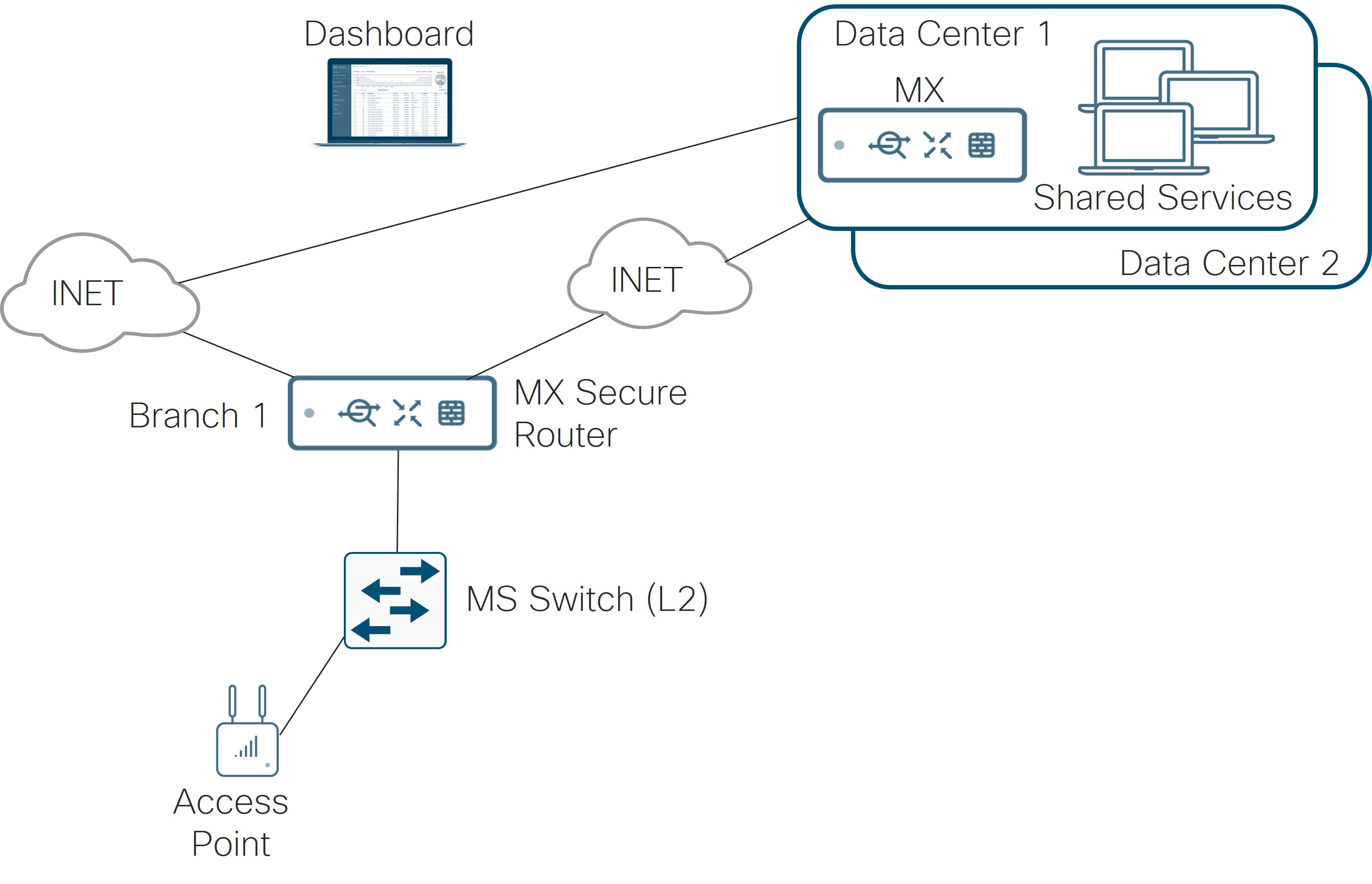
Syslog server configuration is under Network-wide settings. It allows you to configure a server address, port, and what event types to send messages for. This design leverages syslog.
NetFlow
NetFlow is a monitoring tool that exports IP network traffic flow statistics where it can be analyzed by a NetFlow collector. NetFlow is supported on MX routers and 9300/X/L-Ms, and 9200/L-Ms. On the MX, NetFlow data is only exported for traffic that hits the CPU (traffic that is routed or NAT’ed). NetFlow version 9 is supported. This design leverages NetFlow.
Deployment Example
The following topology depicts a branch (Branch 1) composed of an MX secure router, an MS Layer-2 LAN switch, and an access point. There are two WAN interfaces, each connected to an Internet transport. Branch 1 is configured in a hub and spoke topology, with data center 1 as the primary hub and data center 2 as the secondary. The spoke receives a default route from the hubs for forwarding of Internet traffic with some exceptions. At the data center, multiple shared services exist, including DNS, DHCP, radius, and various management platforms for SNMP, syslog, and NetFlow. For SNMP, traps from the dashboard and polling to the dashboard and devices are implemented.

See Appendix C to view the hardware models and code versions used in this example topology. New dashboard GUI versions were used wherever possible at the time of this writing (September 2025). Also, Appendix A reflects the dashboard and device settings that were used so the step-by-step and screenshots can be skipped if desired. Appendix B illustrates the ISE RADIUS configuration used in testing wired and wireless 802.1X for this example topology.
The following details further describe the network:
● The MX router for the hubs and branch are deployed in Routed mode.
● The following describes the six interface VLANs that are defined. The subnet structure is designed so global firewall rules can be minimized. DHCP can be local to the branch or relayed to the data center to a centralized DHCP server. The DNS server can be located on the Internet or at the data center. Some VLANs are not advertised across the auto VPN overlay (indicated by Disabled under the VPN Mode column).
| VLANs |
Subnet Structure |
DHCP Location |
DNS Location |
VPN Mode |
| VLAN 1 (default) |
192.168.128.0/24 |
Local |
Internet (Use OpenDNS) |
Disabled |
| VLAN 10 (DATA) |
10.<VLAN#>.<SITE#>.0/24 |
Data Center |
Data Center |
Enabled |
| VLAN 20 (VOICE) |
10.<VLAN#>.<SITE#>.0/24 |
Data Center |
Data Center |
Enabled |
| VLAN 30 (IOT) |
10.<VLAN#>.<SITE#>.0/24 |
Data Center |
Data Center |
Enabled |
| VLAN 50 (Guest) |
172.16.99.0/24 |
Local |
Internet (Use OpenDNS) |
Disabled |
| VLAN 999 (INFRA) |
10.250.<SITE#>.0/24 |
Local |
Data Center |
Enabled |
● VLAN 1 is used for initial onboarding to the dashboard, then all device management is switched to tagged VLAN 999 with unique addressing so this traffic can use the various services in the data center, such as radius, and syslog/NetFlow/SNMP services.
● In general, traffic from one VLAN cannot access another VLAN due to firewall rules. Exceptions are made for shared services (printer services within the branch and shared services within the data center). Guest and Default VLAN traffic and some traffic from the DATA and INFRA VLANs are permitted to go out Direct Internet Access (DIA).
● The WAN uplinks on the MX router are set to rate limit on the provider sub-line rate, and VPN tunnels are formed on both WAN transports. No load-balancing is done for Internet traffic. Internet break-out traffic is confined to Guest and default VLAN traffic, a few corporate SaaS applications, and dashboard traffic for the INFRA VLAN for downstream devices. All other traffic that is Internet-bound goes through the primary hub over the VPN Auto Tunnel before exiting to the Internet.
● Performance-based routing is enabled for corporate SaaS traffic using the Internet break-out, and VoIP and video conferencing, a custom critical application, and default traffic using the Auto VPN overlay.
● All trunk port connections in this example carry all VLANs, including the native VLAN 1. The MX router has one trunk connection to the switch, and all other ports are disabled. The switch has a trunk connection to the MX router and to the access point, which carries all VLANs, including the native VLAN 1. The access ports of the switch are configured for BPDU guard, storm control, and 802.1x/MAB.
● 802.1x enabled on the access ports of the switch leverage an ISE 3.4 server using RADIUS authentication and accounting. Single-Host mode is used. The policy type is hybrid authentication, meaning, if there is no authentication for 802.1x, Mac Authentication Bypass can be used instead. Voice authentication is also enabled. There is no access to the network if either 802.1x or MAB authentication fails. If authentication succeeds, a VLAN is passed back from the RADIUS server, putting the user into the DATA, VOICE, or IOT VLANs.
● For QoS on the switch, the Guest VLAN traffic DSCP is not trusted and set to DSCP 0. For other VLAN traffic, DSCP is trusted. On the MX router, default traffic rules are used, and rules are added to include guest traffic and custom critical application traffic.
● Wireless guest traffic is configured for Open authentication (no encryption), mandatory DHCP, and a click-through splash page which must be acknowledged before being allowed on the network. DHCP is performed by the MX router and traffic is tagged for the Guest VLAN (VLAN 50). Layer 2 LAN isolation is enabled so guest users cannot communicate with each other, and a per-client bandwidth and per-SSID bandwidth limit is enabled. SSID availability is scheduled according to a custom schedule. The Guest Wi-Fi uses 2.4 and 5 GHz bands and AI-RRM is enabled.
● Corporate Wi-Fi traffic is configured to use 802.1x Enterprise authentication with RADIUS (authentication and accounting). WPA3 transition mode is used, and fast roaming and protected management frames are enabled (Protected management frames allow unsupported clients). DHCP is performed by the MX router and by default, traffic is tagged for the DATA VLAN, although the Override VLAN tag is enabled. RADIUS will respond back with a group policy name (Employees, Voice, or IOT) which has a VLAN set based on the identity of the user. SSID availability is scheduled according to a custom schedule. The Corp Wi-Fi uses 2.4, 5, and 6 GHz bands, Band steering, and AI-RRM is enabled.
● Wi-Fi 7 is not enabled yet for the Corporate Wi-Fi as it requires a separate access point from the guest Wi-Fi due to security requirements. Per-group SSID configuration is available starting in MR release 32.1.4, where Wi-Fi 7-compliant SSIDs can co-exist on the same AP as non-Wi-Fi 7-compliant SSIDs as long as they are in separate SSID groups. See WPA3_Encryption and Configuration Guide for additional information.
For this deployment, the following steps are discussed:
● Complete the prerequisites
● Create a new network
● Configure the devices
● Onboard the devices/Verify device operation
● Complete device configurations
Once the devices are onboarded and verified, configuration templates can be created then modified from a configured network which can then be used to quickly deploy additional branches. See Managing Multiple Networks with Configuration Templates for more details.
Complete the Prerequisites
There are several prerequisites that need to be addressed before configuration and onboarding can begin.
● All configurations can be performed on the Meraki cloud dashboard. Devices should have connectivity to the Internet to connect to the Meraki cloud. Device onboarding is simplified if the provider provides an IP address, gateway, and DNS information through DHCP to the WAN uplink on the MX router, as device registration to the dashboard is automatic. In addition, it is important to ensure that if there are any firewalls upstream from the router, the proper rules are configured so the device can reach the proper cloud services. See Upstream Firewall Rules for Cloud Connectivity for details on what IP addresses and ports need to be allowed.
● Ensure a Meraki dashboard account and Organization is created. The organization is created at the same time as the account. From the account, organizations, networks, and devices are managed. An organization is made up of multiple networks, and each network is made up of one or more devices. A network typically correlates to a physical location. See Creating a Dashboard Account and Organization for more information.
● Ensure the devices to be managed are added in the Organization inventory on the dashboard (Organization>Configure>Inventory). They can be entered using an order number or serial number.
● Ensure the required licenses are added to the dashboard. License status can be found on the Organization>Configure>License Info page on the dashboard. Licenses are added automatically if they are part of an order number that was entered in the Inventory page, otherwise, they can be added manually using a Claim Key if the order number is not known or the license is ordered separately from the devices.
For more detailed information, review the Getting Started Checklist.
Create a New Network
On the dashboard, go to Organization>Configure>Create Network. In the text box, type the Network name (RTP6-Branch1) and specify the Network type (if needed) from the drop-down box (Combined hardware). This network will use the Default Meraki configuration before additional configurations are added. Select the devices from inventory which should be included in the network (these should have been added during the prerequisite steps). Select Create network.
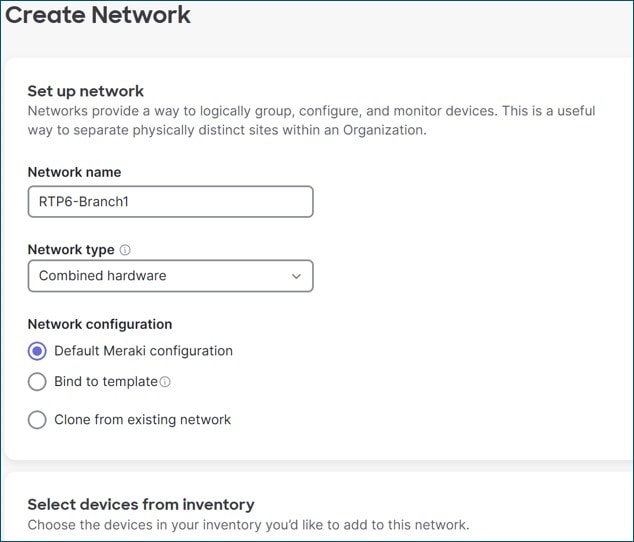
The dashboard switches to the newly created network.
Configure the Devices
The devices can be pre-configured before onboarding. The following sequence creates a majority of the configuration before onboarding and leaves some port-level configuration until after onboarding. From the RTP6-Branch1 network, the MX router, switch, and AP are configured.
Name the Devices
By default, the MX, switch, and AP devices are named by their mac-addresses. To give them more user-friendly names:
● MX: Go to Security & SD-WAN>Monitor>Appliance Status, click edit next to the mac address in the top left corner, and fill in the Appliance name (RTP6-Branch1-MX). Click Save.
● Switch: Go to Switching>Monitor>Switches, choose the switch mac address to view, click edit next to the mac address in the top left corner, and fill in the Switch name (RTP6-Branch1-SW1). Click Save.
● AP: Go to Wireless>Monitor>Access Points, choose the AP mac address to view, click edit next to the mac address in the top left corner, and fill in the Access point name (RTP6-Branch1-AP1). Click Save.

Network-wide: Configure Time Zone
Time zone is used for time-sensitive features such as SSID Availability or Port Scheduling. In this example, it is used to set the schedule for SSID availability. Go to Network-wide>Configure>General. Next to Local time zone, select the appropriate time zone from the drop-down box if it’s not already configured. In this example, America – New York (UTC -4.0, DST) is selected. Click Save or Save Changes.

MX Secure Router: Configure VLAN Interfaces
Under Security & SD-WAN>Configure>Addressing & VLANs>Routing>LAN setting, select VLANs. VLAN 1 is automatically created with a VLAN interface IP of 192.168.128.1/24. In the Subnets section, click Add VLAN. Enter VLAN name (DATA) and VLAN ID (10). Click Next.

Under Add VLAN>IPv4 Config>VLAN interface IP, enter the IP address of the MX gateway for VLAN 10 (DATA) (10.10.1.1). This is in the form 10.<VLAN#><SITE#>.1 so global firewall rules for site-to-site VPNs can be efficiently applied. Under Subnet, the VLAN subnet is specified (10.10.1.0/24). Next to IPv6 Config, Disabled has been selected for this VLAN. Click Preview, then Update.
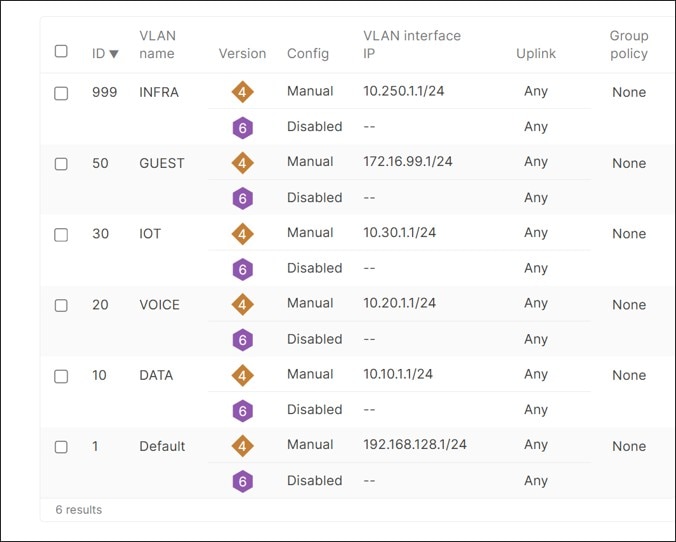
Repeat the steps to add additional VLANs for 20 (VOICE), 30 (IOT), 50 (GUEST), and INFRA (999). VLAN 1 interface IP address is left at default (192.168.128.1) and VLAN 999 (INFRA) interface IP address is configured as 10.250.<site#>.1. VLANs 10, 20, 30 interface IPs follow the scheme 10.<VLAN#><Site#>.1. All subnets are /24 masks. All guest traffic on all branches will share the same subnet (172.16.99.0/24).
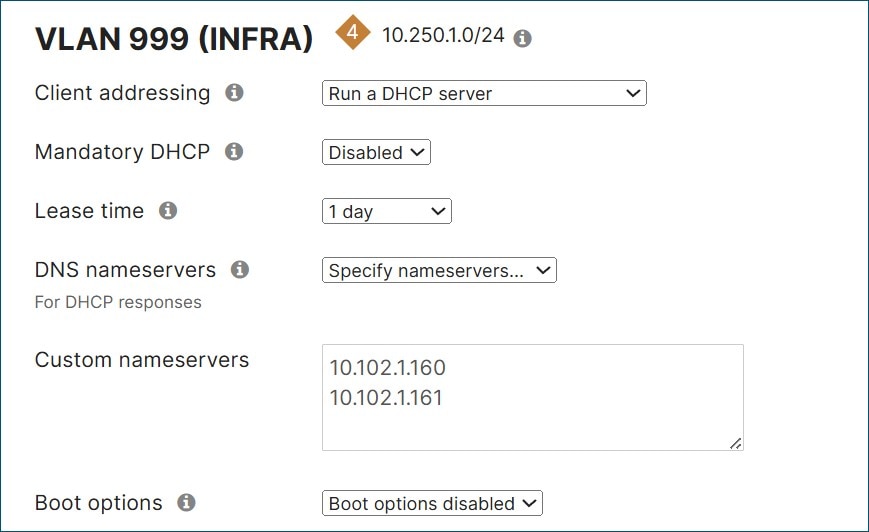
Click Save.
MX Secure Router: Configure DHCP
In this network, the Default, INFRA, and GUEST VLANs use local DHCP pools, while the other subnets use DHCP services in the data center. INFRA devices use reserved IP addresses from the DHCP pool. All DHCP pools are local by default and proxy to an upstream DNS, which is out on the Internet transport. Only GUEST and Default VLANs should use an Internet DNS server (OpenDNS), while everything else uses DNS services in the data center.
Before configuring this section, gather the mac addresses from any switches and access points so the Management IP addresses can be reserved from the DHCP pools.
| Dashboard Location |
Mac Address |
|
| RTP6-Branch1-SW1 |
Switching>Monitor>Switches>MAC address |
6c:c3:b2:7e:ae:0a |
| RTP6-Branch1-AP1 |
Wireless>Monitor>Access Points>MAC address |
cc:6e:2a:dd:f8:c0 |
Go to Security & SD-WAN>Configure>DHCP and under VLAN 999 (INFRA) next to DNS nameservers, select Specify nameservers. Next to Custom nameservers, type in the DNS servers at the data center (10.102.1.160 and 10.102.1.161 in this example).
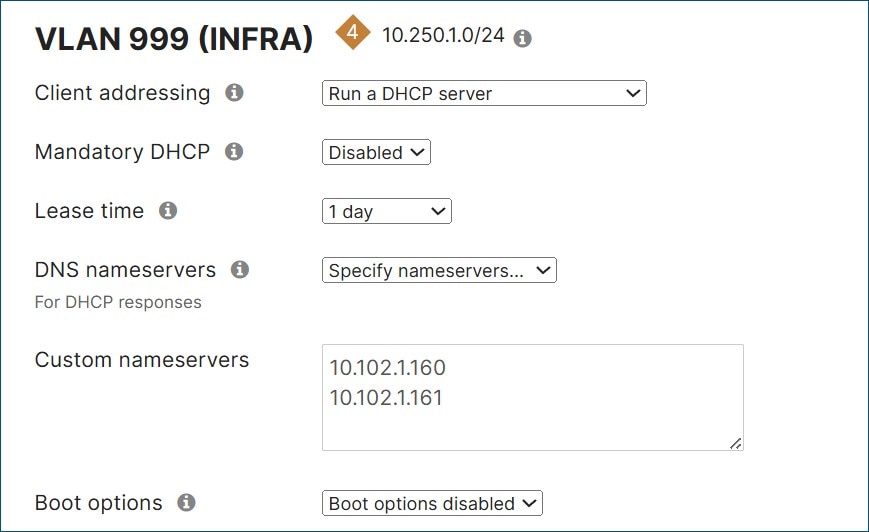
Next to Fixed IP assignments, click Add a fixed IP assignment. Enter a name for the device, the mac address, and what LAN IP address is to be assigned. Repeat for all devices.

Click Save Changes at the bottom of the page.
For VLANs 10, 20, and 30, next to Client addressing, select Relay DHCP to another server and next to DHCP server IPs, type in the data center DHCP servers (10.102.1.160 and 10.102.1.161 in this example). Click Save or Save Changes.
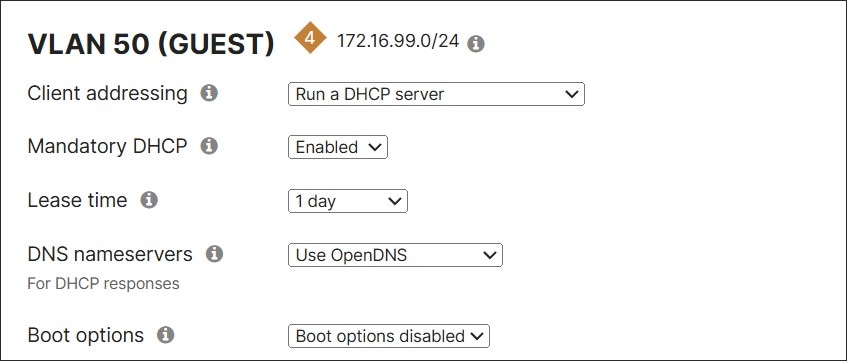
Note: The DHCP relay IP address must be in a subnet connected to the network or on a subnet reachable through the site-to-site VPN (not through the default route). In the example data center, there is a static route defined to reach the DC services network, and that static route is in VPN mode so it can be advertised to other Auto VPN members.
For the GUEST VLAN (50) and Default VLAN (1), next to Mandatory DHCP, select Enabled from the drop-down box. Next to DNS nameservers, select Use OpenDNS from the drop-down box. Click Save or Save Changes.

MX Secure Router: Configure Site-to-Site VPNs and Data Center Default Route
Under Security & SD-WAN>Configure>Site-to-site VPN, next to Type, select Spoke. Next to Hubs, click Add a hub and select the primary hub (RTP6-DC1 – appliance in this example). Click Add a hub and select the secondary hub (RTP6-DC2 – appliance in this example). Since DC1 was selected first, this prioritizes DC1 as the primary hub, so if routes are equal, DC1 is selected to route the traffic.
Under IPv4 default route, select checkboxes next to both hubs since both can route default traffic. Click Save or Save Changes.

MX Router: Configure VPN Settings for VLANs
By default, subnets are not advertised to other sites through the VPN registry. Under Security & SD-WAN>Configure>Site-to-site VPN, under VPN settings>Local networks, choose Enabled under VPN mode for DATA, VOICE, IOT, and INFRA so these networks can be advertised. Click Save or Save Changes.

MX Secure Router: Configure Firewall Rules
Firewall rules apply to LAN traffic as well as Internet traffic. It does not apply to VPN site-to-site traffic. The following policy is implemented:
● Allow Data VLAN to access local Printers (10.30.1.101 and 10.30.1.102) on the IOT VLAN. The Layer 3 firewall rules are stateful, so traffic in the opposite direction is allowed back through.
● Allow Direct Internet Access (DIA) for Default, INFRA, DATA, and GUEST VLANs.
● Deny everything else. This does not affect VPN site-to-site traffic, which is governed by site-to-site VPN firewall rules. This means that all VLAN-to-VLAN layer 3 traffic will be blocked and IOT and VOICE VLANs will be denied DIA as well.
First, a policy object is created. Go to Organization>Configure>Policy Objects. Under the All objects tab, click Add new. Under Name, type in a name (Branch 1 Printer 1 in this example) and under FQDN, IP or CIDR, add an IP host (10.30.1.101 in this example). Click Create object.
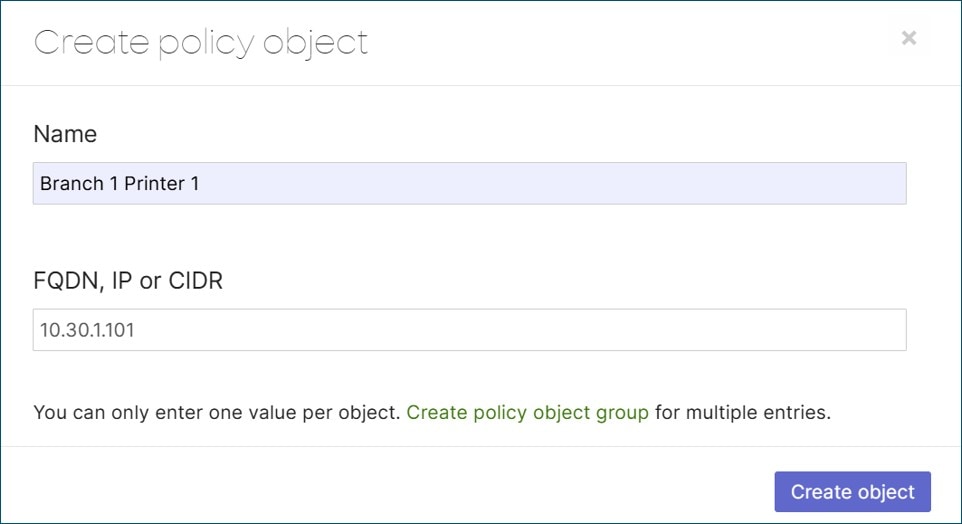
Repeat the steps for Branch 1 Printer 2 (10.20.1.102).
A policy object group can be created from the newly created objects. From Organization>Configure>Policy Objects under the Groups tab, click Add new. Under Group name, type Branch 1 Printers, then under Contains, type Branch 1, and from the drop-down box, select the Branch 1 Printer 1 object. Then add the Branch 1 Printer 2 object. Click Create group.

The Network object group is updated. Select Close on the pop-up window.
Select Security & SD-WAN>Configure>Firewall and under Layer 3>Outbound rules, click Add new. Fill out the parameters and click Add new to add the next rule as shown in the table below.
| Policy |
Rule Description |
Protocol |
Source |
Src Port |
Destination |
Dst Port |
| Allow |
Local Print Access |
Any |
DATA VLAN |
Any |
Branch 1 Printers (Object group) |
Any |
| Allow |
Allow DIA |
Any |
Default VLAN/INFRA VLAN/DATA VLAN/GUEST VLAN |
Any |
Any |
Any |
| Deny |
Deny All |
Any |
Any |
Any |
Any |
Any |
| Allow |
Default rule |
Any |
Any |
Any |
Any |
Any |
Once complete, click Finish editing, then Save or Save Changes.

MX Secure Router: Configure VPN Site-to-Site Outbound Firewall Rules
The VPN site-to-site outbound firewall rules apply to outbound VPN traffic destined to other VPN-connected sites and is applied at an organization level, meaning, these same rules apply to every MX router in the organization with site-to-site VPN enabled. This is important as it influences the way the rules should be crafted. In the example network, the network scheme is 10.<vlan#><site#>.0/24 so firewall rules could be applied more easily at the organizational level. The Data VLAN across the organization is represented by the subnet 10.10.0.0/16 instead of a list of disjointed 10.x networks.
While the L3 firewall rules on the device can reference VLANs inside the rules, the site-to-site VPN firewall rules do not. Only policy objects, policy object groups, IPv4/v6 addresses, or subnets can be referenced. The following policy is implemented:
● Allow the Data, IOT, Voice, and Infra subnets in any branch to reach Corporate shared services (DHCP, DNS, Radius, SNMP, and Management) and allow Corporate shared services to reach the Data, IOT, Voice, and Infra subnets in any branch.
● Deny access from Data, IOT, Voice, and Infra subnets to other subnets in other sites. Meaning, Data subnets cannot reach IOT, Voice, and Infra subnets, etc.
● Allow everything else. This is the default rule and allows Data subnets to reach other Data subnets as well as the Internet through the hub. Voice subnets can reach other voice subnets as well as the Internet through the hub, etc.
Note that Guest and Default traffic do not traverse the VPN overlay due to VPN mode being disabled for these VLANs. They can be included in the rule as “Deny Guest subnet or Default subnet to Any” and “Deny Any to Guest subnet or Default subnet” if desired, in the event the Guest or Default VLAN’s VPN mode is enabled, and a unique subnet is configured.
Go to Organization>Configure>Policy Objects and create the following objects and object group. Note that objects within policy groups can be created before the policy group object is created or after the policy group object is defined.
| Object or Object Group |
Name |
Type |
Value |
| Object |
Corp DNS-DHCP |
CIDR |
10.102.1.160 |
| Object |
Corp Mgt |
CIDR |
10.102.1.160 |
| Object |
Corp Radius |
CIDR |
10.102.1.160 |
| Object |
Data Subnet |
CIDR |
10.10.0.0/16 |
| Object |
Voice Subnet |
CIDR |
10.20.0.0/16 |
| Object |
IOT Subnet |
CIDR |
10.30.0.0/16 |
| Object |
Infra Subnet |
CIDR |
10.250.0.0/16 |
| Object Group |
Corp Shared Services |
-- |
Corp DNS-DHCP/Corp Mgt/Corp Radius |
Go to Security & SD-WAN>Configure>Site-to-Site VPN. Under Site-to-site outbound firewall, configure the following:
| Policy |
Rule Description |
Protocol |
Source |
Src Port |
Destination |
Dst Port |
| Allow |
Shared Services |
Any |
Data Subnet/IOT Subnet/Voice Subnet/Infra Subnet (Objects) |
Any |
Corp Shared Services (Object group) |
Any |
| Allow |
Shared Services |
Any |
Corp Shared Services (Object group) |
Any |
Data Subnet/IOT Subnet/Voice Subnet/Infra Subnet (Objects) |
Any |
| Deny |
Data Access |
Any |
Data Subnet (Object) |
Any |
Voice Subnet/IOT Subnet/Infra Subnet (Objects) |
Any |
| Deny |
Voice Access |
Any |
Voice Subnet (Object) |
Any |
Data Subnet/IOT Subnet/Infra Subnet (Objects) |
Any |
| Deny |
IOT Access |
Any |
IOT Subnet (Object) |
Any |
Data Subnet/Voice Subnet/Infra Subnet (Objects) |
Any |
| Deny |
Infra Access |
Any |
Infra Subnet (Object) |
Any |
Data Subnet/Voice Subnet/Infra Subnet (Objects) |
Any |
| Allow |
Default Rule |
Any |
Any |
Any |
Any |
Any |
Click Save Changes.

MX Secure Router: Configure SD-WAN & Traffic Shaping
Uplink Configuration
In this example, rate limiting is set on each WAN link to match the provider’s service sub-line rate. Go to Security & SD-WAN>Configure>SD-WAN & Traffic Shaping. Under Uplink configuration, set WAN 1 to 400 Mbps and WAN 2 to 500 down (Mb/s) and 500 up (Mb/s) in this example.
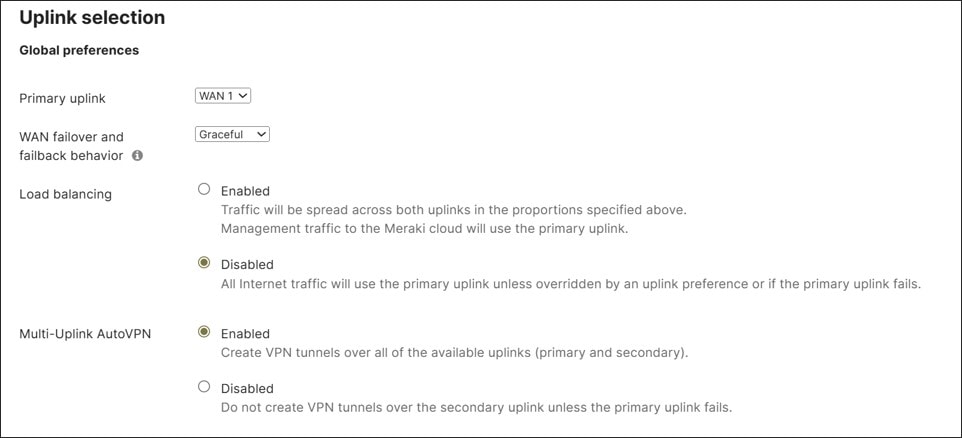
In this example, the Primary uplink is kept as WAN 1 (default). There is also no Load balancing enabled for Internet traffic. Most Internet traffic takes the tunnel to the primary hub. Guest traffic, Data/Corporate SaaS traffic (O365 and Webex), device dashboard INFRA traffic, and Default traffic (if any) takes the direct Internet access from the branch.
In addition, VPN tunnels are created over both available uplinks (Multi-Uplink AutoVPN is Enabled).
L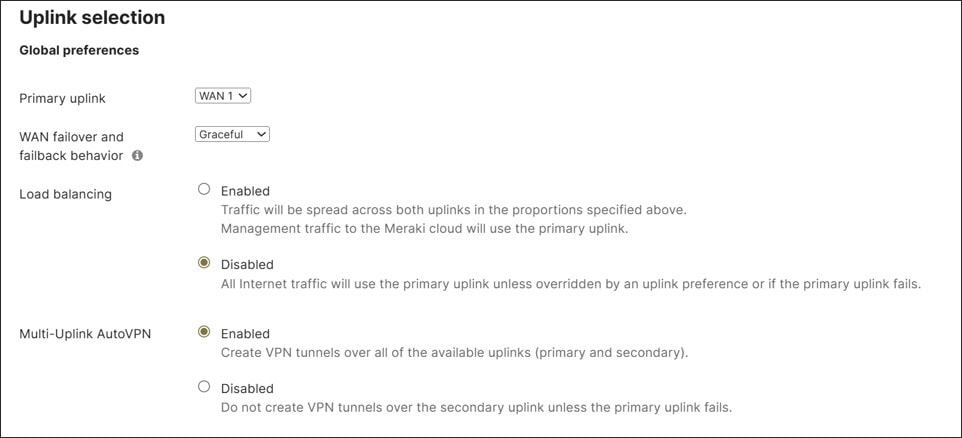
Local Internet Breakout
Because default routes are pointing to the hubs, the site is assumed to be in full-tunnel mode. This means that all Internet traffic is sent through the hub. The exception is Guest (and Default VLAN) traffic because their VPN mode is set to disabled and Internet access for these VLANs is allowed as a rule in the L3 firewall. To break out traffic for DIA, VPN exclusions first need to be configured. In this example, SaaS application (Office 365 and Webex) traffic from the Corporate/Data VLAN need to be broken out, as well as dashboard INFRA VLAN traffic for the switch and AP control planes.
Go to Security & SD-WAN>Configure>SD-WAN & Traffic Shaping and under Local internet breakout next to VPN exclusion rules, click the Add + button, select Major applications and choose Office 365 Suite and Webex. Under Custom expressions, specify the Protocol, Destination, and Dst port, then click Add expression. Use the following custom expressions to allow dashboard cloud communication and VPN registry traffic. Any is used for the destination port since only one port, or Any can be specified per custom expression. See Upstream Firewall Rules for Cloud Connectivity for latest, up-to-date port requirements for the dashboard.
| Protocol |
Destination |
Dst Port |
| UDP |
64.62.142.12/32 |
Any |
| UDP |
158.115.128.0/19 |
Any |
| UDP |
209.206.48.0/20 |
Any |
| UDP |
216.157.128.0/20 |
Any |
Click Save or Save Changes.

SD-WAN Policies: Internet
In this part of the configuration, traffic steering and performance-based routing policies are configured. The first section applies to Internet traffic only. Because no load-balancing is configured, traffic chooses the primary uplink (WAN 1 in this case) unless there is a policy to steer it differently. In this example, the following policies are desired:
● Guest traffic is directed over WAN 1. If the link is declared down, the traffic is redirected to WAN 2.
● SaaS Traffic is directed over WAN 2 and should be redirected to WAN 1 if performance is poor.
● Device dashboard traffic is directed over WAN 2. If the link is declared down, the traffic is redirected to WAN 1.
Guest traffic doesn’t need to be included in the policy since this is the default behavior when no load-balancing is chosen and the primary uplink is WAN 1.
A custom performance class for SaaS traffic should be configured before configuring the policy. Go to Security & SD-WAN>Configure>SD-WAN & Traffic Shaping and under SD-WAN policies and Custom performance classes, select Create a new custom performance class. Fill in the Name (SaaS_Traffic), Maximum latency (ms) (150), Maximum jitter (ms) (50), and Maximum loss (%) (5). Click Save or Save Changes.
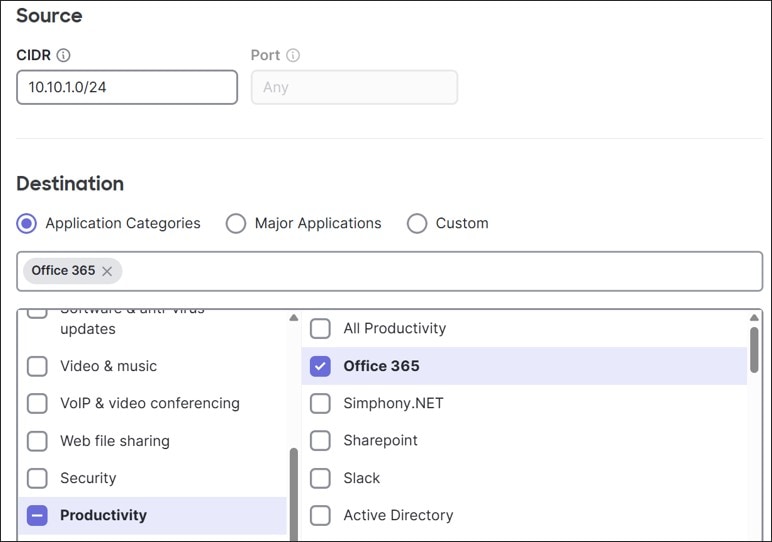
Under SD-WAN Policies>Internet Traffic, click + Add policy, specify the Protocol, Source CIDR, Destination, and Uplink Selection. Click Save to Add the policy to the dashboard. Repeat to add additional lines of policy.
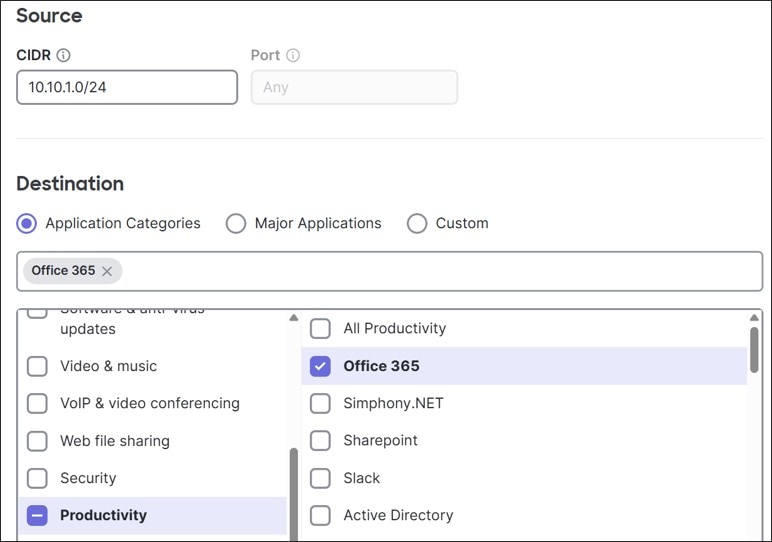
The following two uplink selection policies are configured in this example:
| Source |
Destination Type |
Value |
Preferred Uplink |
Fail Over If: |
Performance Class: |
|
| Any |
10.10.1.0/24 |
Application Categories |
Productivity>Office 365 VoIP & video conferencing>Webex |
WAN 2 |
Poor performance |
SaaS_Traffic |
| Any |
10.250.1.0/24 |
Custom |
CIDR=Any |
WAN 2 |
Uplink Down |
N/A |
Note that dashboard destination traffic is Any. The VPN exclusions already defined what specific destination traffic is DIA (dashboard IP address destinations). Click Save or Save Changes.

SD-WAN Policies: VPN Traffic
In this part of the configuration, traffic steering and performance-based routing policies are configured for VPN traffic. Load-balancing doesn’t apply to VPN traffic, so VPN traffic always chooses the primary link (WAN 1 in this case) unless there is a policy to steer it differently. In this example, the following policies are desired:
● All VoIP and Video Conferencing traffic is directed over WAN 2 and should be redirected to WAN 1 if performance is poor.
● A critical company application (TCP from Any to 10.102.1.161/32:443) is directed over WAN 2 and should be redirected to WAN 1 if performance is poor.
● All other traffic is directed over WAN 1 and should be redirected to WAN 2 if performance is poor.
Custom performance classes for the critical application traffic and default traffic should be configured before configuring the policy. Go to Security & SD-WAN>Configure>SD-WAN & Traffic Shaping, then under SD-WAN policies and Custom performance classes, select Create a new custom performance class. Fill in the Name (Critical_Apps), Maximum latency (ms) (150), Maximum jitter (ms) (20), and Maximum loss (%) (2).
Select Create a new custom performance class. Fill in the Name (Default_SLA), Maximum jitter (ms) (100), and Maximum loss (%) (5).
Click Save or Save Changes.

Under SD-WAN Policies>VPN traffic, click Add a preference. Under Traffic filters, click Add + and select an application or application family or create a custom expression to match VPN traffic. Select the preferred uplink and click Save. Repeat to add any additional lines of policy.

The following two uplink selection policies are configured in this example:
| Traffic Filters |
Preferred Uplink |
Fail Over If: |
Performance Class: |
| All VoIP & video conferencing |
WAN 2 |
Poor performance |
VoIP |
| Layer 3 TCP from Any to 10.102.1.161/32:443 |
WAN 2 |
Poor performance |
Critical_Apps |
| Layer 3 Any to Any |
WAN 1 |
Poor performance |
Default_SLA |
Click Save or Save Changes.

Traffic Shaping Rules
In this example, the default traffic shaping rules are kept and only two additional rules are added. The two rules are to give lower priority to guest traffic and give higher priority to the critical application traffic that was referenced in SD-WAN polices>VPN traffic. Next to Default Rules, ensure that Enable default traffic shaping rules is selected.
Under Traffic shaping rules, click Add a new shaping rule. Indicate what traffic should be matched, what bandwidth limit should be applied if any, what priority should the traffic be treated as, and any DSCP tagging requirements.
The following is configured for this example:
| Rule # |
Definition |
Bandwidth Limit |
Priority |
DSCP Tagging |
| 1 |
localnet 172.16.99.0/24 (guest) |
Ignore network per-client limit (unlimited) |
Low |
0 (CS0/DF – Best Effort/Default Forwarding) |
| 2 |
net/port 10.102.1.161/32:443 |
Ignore network per-client limit (unlimited) |
High |
18 (AF21 – Low Latency Data, Low Drop) |
Click Save Changes.
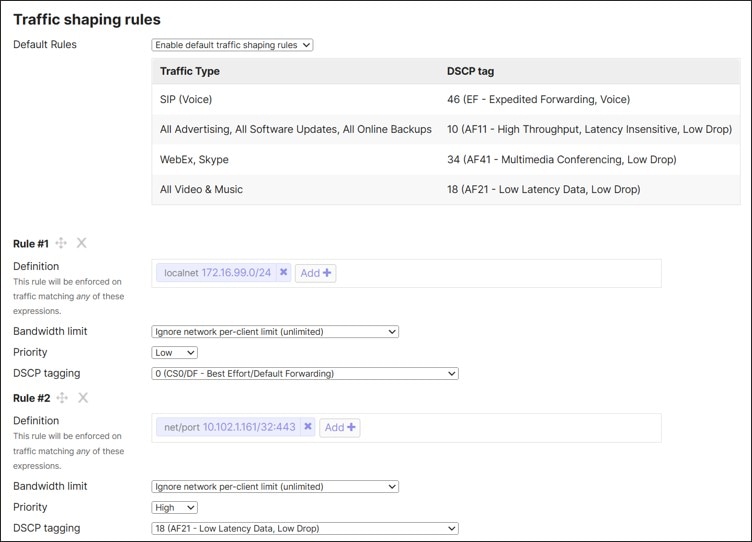
MX Secure Router: Configure Threat Protection
Under the Security & SD-WAN>Configure>Threat Protection page, Advanced Malware Protection (AMP) and Intrusion detection and prevention can be configured. Under Advanced Malware Protection (AMP), ensure the Mode is set to Enabled. Under Intrusion detection and prevention, set the Mode to Prevention and choose Balanced next to Ruleset. Click Save or Save Changes.

MX Secure Router: Configure Content Filtering
Go to Security & SD-WAN>Configure>Content Filtering. Under Category blocking, select what content and threat categories should be blocked, as well as any URLs that should be allowed or blocked under URL filtering. In this example, the following was configured:

www.example.com is included in the URL filtering blocked URL list.

Click Save.
Switch: Configure the Spanning Tree Root
The switch is configured to be the root of spanning tree. Go to Switching>Configure>Switch Settings under STP configuration. Click Set the bridge priority for another switch or stack. A window may pop up warning that changing the STP bridge priority may cause a short disruption on all switches in the network as spanning tree is re-calculated. Click Got it.
Choose the Switches/Stacks name from the drop-down box (RTP6-Branch1-SW1) and select 4096 from the drop-down box under Bridge priority. Click Confirm.
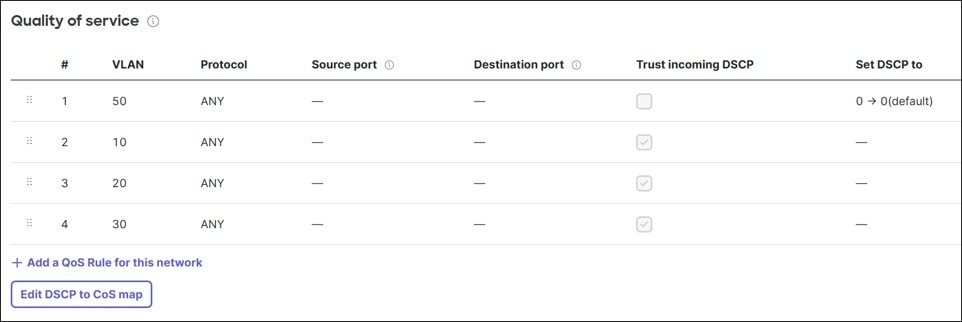
Click Save changes.
Switch: Configure Quality of Service
In this example, minimal Quality of Service configurations are made. Under Switching>Configure>Switch Settings>Quality of service, default DSCP-to-CoS mappings are retained. Guest traffic (VLAN 50) is untrusted with all traffic set to 0 (default), while incoming DSCP is trusted for Data (VLAN 10), Voice (VLAN 20), and IOT traffic (VLAN 30).

Switch: Configure Storm Control
In this example, storm control is configured on the wired access ports. Go to Switching>Configure>Switch Settings and under Storm control, click + Set the port bandwidth for another traffic type. Enter the Traffic type and % of available port bandwidth. Click Confirm. Repeat to finish the traffic types. When finished, click Save changes.
While percentages for what’s normal traffic may vary for each network, in this example, Broadcast traffic is set to 20% while Multicast and Unknown Unicast is set to 10%.
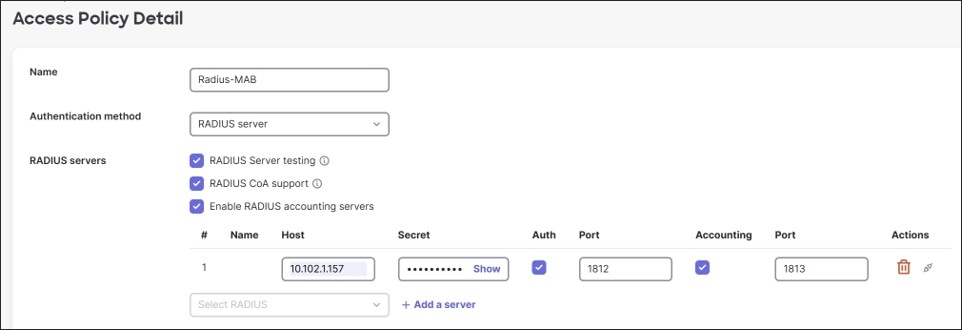
Switch: Configure Access Policies
To configure 802.1x on the switch in this example, go to Switching>Configure>Access Policies. Click + Add policy. Configure a Name (Radius-MAB) and Authentication method (RADIUS server). Enable RADIUS Server testing, RADIUS CoA support, and RADIUS accounting servers. Click + Add a server and fill in the Host, Secret, and Port number for RADIUS Authentication. Repeat to add information on the RADIUS Accounting server.

Next to Connection, select Hybrid authentication since both 802.1x and Mac Authentication Bypass can be utilized. Host mode is set to Single-Host by default and 802.1x control direction defaults to Both. Next to Options, select Voice auth.

Click Save.

Switch: Configure Port Profiles
Port profiles can shortcut port configurations. In the example, one port profile is created for the ports connected to access points and another port profile is created for wired clients.
Go to Switching>Configure>Port Profiles. Click + Add profile. Fill out the Profile name, specify the Type of port, RSTP enabled/disabled, STP guard, any SGT settings, UDLD setting, PoE setting, and Storm control. Then click Save and repeat for additional profiles.
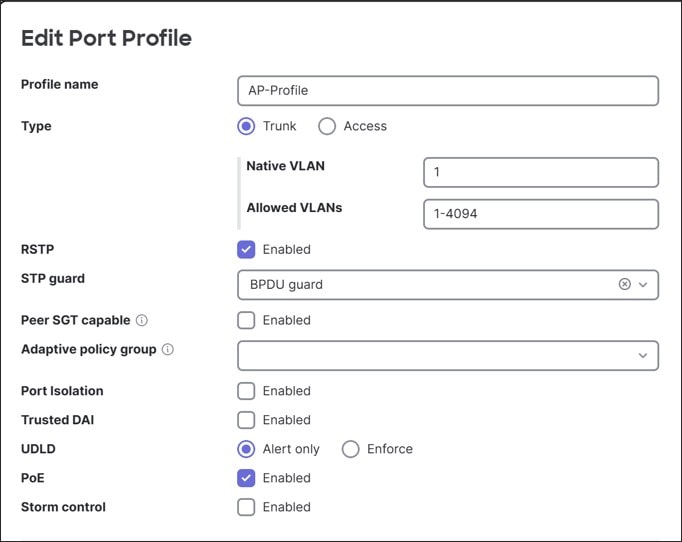
The following profiles are created in this example:
| Profile Name |
Type |
RSTP |
STP Guard |
UDLD |
PoE |
Storm control |
| AP-Profile |
Trunk
● Native VLAN 1
● Allowed VLANs 1-4094
|
Enabled |
BPDU guard |
Alert only |
Enabled |
Disabled |
| Data-Profile |
Access
● Access policy: Radius-MAB
● VLAN 10
● Voice VLAN 20
|
Enabled |
BPDU guard |
Alert only |
Enabled |
Enabled |

Wireless Access Point: Configure Guest SSID
Access Control
Go to Wireless>Configure>Access Control. Select an unconfigured SSID from the drop-down box. Provide an SSID name (in this example RTP6-BR1-GuestWiFi), and next to SSID status, select Enabled. The SSID will not be hidden.

Select Security (Open (no encryption)), enable Mandatory DHCP, and under Splash page, choose Click-through – this requires guests to view and acknowledge a splash page before being allowed on the network.
Under Client IP and VLAN, select External DHCP server assigned and leave the setting in Bridged mode. Next to VLAN tagging, choose VLAN ID from the drop-down box, and in the VLAN ID box, type 50, which is the Guest VLAN already defined on the MX router and carried on the trunk between the AP/switch and the MX router/switch. Click Save.

Firewall and Traffic Shaping
Under Wireless>Firewall & traffic Shaping, select the guest SSID from the drop-down box (RTP6-BR1-GuestWiFi). Under Block IPs and ports next to Layer 2 LAN isolation, select Enabled.

For this example, set the Per-client bandwidth limit to 50 Mbps and Enable SpeedBurst. Set the Per-SSID bandwidth limit to 100 Mbps. Next to Shape traffic, choose Shape traffic on this SSID and ensure next to Default Rules that Enable default traffic shaping rules is chosen.

Under Outbound rules, ensure that Deny is selected for “IPv4 Any Local LAN Any” for the Wireless clients accessing LAN rule.

Click Save Changes.
Splash Page
Go to Wireless>Configure>Splash Page. Under the Sp l ash page, select the guest SSID (RTP6-BR1-GuestWiFi). Ensure Modern is chosen under Official themes. Under Customize your page next to Welcome message, type “Click to continue if you agree to the terms of usage of this guest service”. Click Save Changes.

Network-Wide: Configure Group Policy
In this example, group policy is applied after RADIUS authentication occurs. The RADIUS server passes back a filter-ID parameter, which corresponds to a group policy name and is applied to the wireless user accessing the network. In this example, there are 3 policy groups: Employees, Voice, and IOT.
Go to Network-wide>Group Policies and click Add a group. Next to Name, type Employees and under Wireless only next to VLAN, select Tag VLAN from the drop-down box and type 10 in the box. Click Save Changes. Repeat for Voice (VLAN 20) and IOT (VLAN 30).

Wireless Access Point: Configure Corporate SSID
Access Control
Go to Wireless>Configure>Access Control. Select an unconfigured SSID from the drop-down box. Provide an SSID name (in this example, RTP6-BR1-CorpWiFi) and next to SSID status, select Enabled. The SSID will not be hidden.
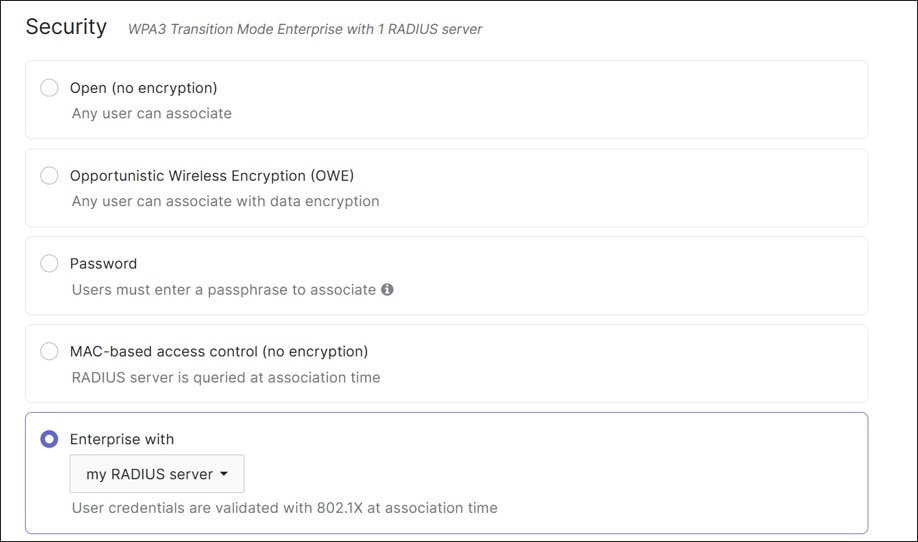
Under Security, choose Enterprise with my RADIUS server.
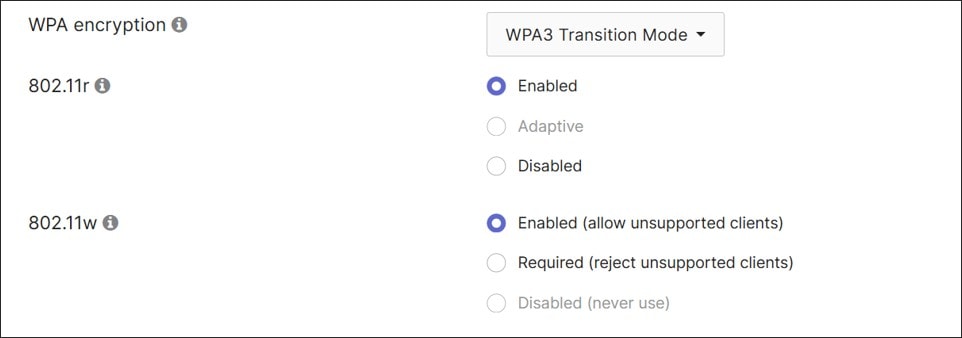
Next to WPA encryption, choose WPA3 Transition Mode. Next to 802.11r (fast roaming) choose Enabled, and next to 802.11w (management frame protection) choose Enabled (allow unsupported clients).

Next to Mandatory DHCP, select Enabled. Under Splash page, choose None (direct access).

To prepare for Wi-Fi 7 mode in the future, under Advanced WPA3 settings, select GCMP 256 next to WPA3 Cipher Suite.
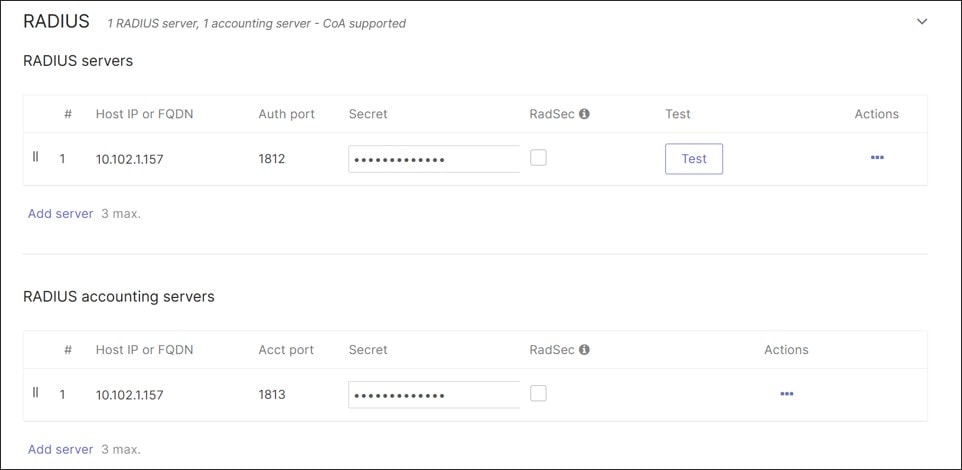
Under RADIUS and RADIUS servers, click Add server and enter the Host IP or FQDN, Auth (Authentication) port, Secret password, and click Done. Under RADIUS accounting servers, select Add server and enter the Host IP or FQDN, Acct (Accounting) port, Secret password, and click Done.

RADIUS CoA is not enabled due to the enabling of the fast-roaming feature. Next to RADIUS attribute specifying group policy name, select Filter-Id.

Under Client IP and VLAN, select External DHCP server assigned and ensure Bridged mode is selected. Next to RADIUS override, ensure that Override VLAN tag is selected. Under VLAN tagging, select VLAN ID, and under VLAN ID, type in 10. This is the default VLAN for authenticated users if VLAN IDs or group policy names are not passed by RADIUS. VLAN 10 is the Data VLAN already defined on the MX router and carried on the trunk between the AP/switch and the MX router/switch. Click Save.

Firewall and Traffic shaping
Under Wireless>Firewall & traffic shaping, select the Corp SSID from the drop-down box (RTP6-BR1-CorpWiFi). Leave defaults. The configuration should look like:
● Layer 2 LAN isolation: disabled
● DHCP guard: Disabled
● RA guard: Enabled
● Outbound rules: Allow IPv4 Any Local LAN Any (Wireless clients accessing LAN)
● Outbound rules: Allow IPv4 Any Any Any (Default rule)
● Traffic shaping rules: Per-client bandwidth limit: unlimited
● Traffic shaping rules: Per-SSID bandwidth limit: unlimited
● Traffic shaping rules: Shape traffic: Shape traffic on this SSID
● Traffic shaping rules: Enable default traffic shaping rules

Wireless Access Point: Configure SSID Availability
In this section, SSID availability is configured. Go to Wireless>SSID Availability and select an SSID (RTP6-BR1-CorpWiFi). Next to Scheduled availability, select enabled. Next to Schedule templates, ensure Custom schedule is selected. Configure the following:
● Sunday, unavailable, From 0:00 to 24:00
● Monday-Friday, available, From 7:00 to 19:00
● Saturday, unavailable, From 0:00 to 24:00
Click Save Changes. Repeat for other SSIDs.

Configure Other Network Services
SNMP (Dashboard Polling)
Go to Organization>Configure>Settings. Under SNMP, ensure the following settings are configured:
● SNMP V2C disabled
● SNMP V3 enabled
● Authentication mode: SHA
● Privacy mode: AES128
Ensure strong passwords are chosen for Authentication and Privacy and configure any IP restrictions (IP address endpoints that are authorized to poll the dashboard).
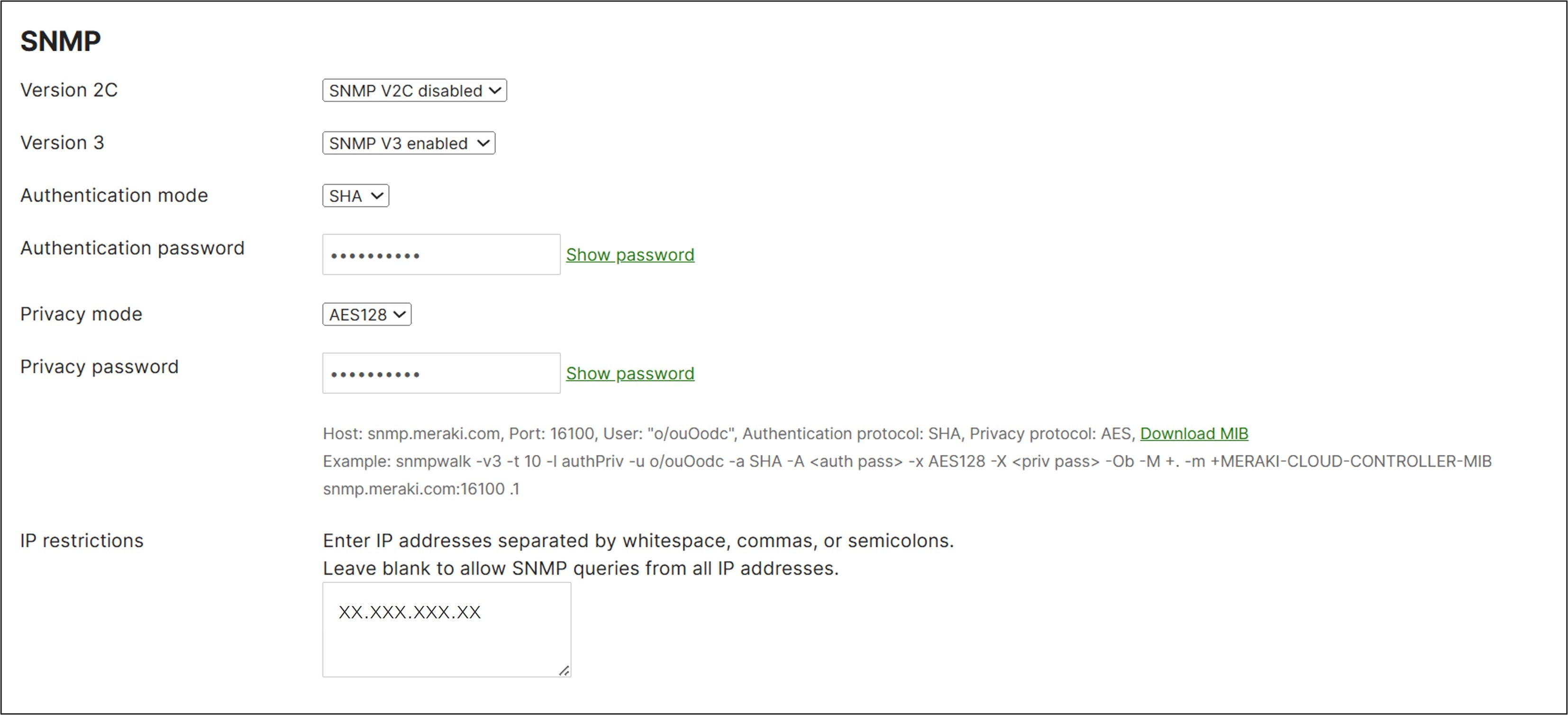
SNMP (Dashboard Traps)
SNMP traps originating from the dashboard are configured at the network-level. Go to Network-wide>Configure>Alerts>SNMP traps. Next to Access, select V3 (username/password). Click Add an SNMP user and fill out an SNMP Username and Passphrase. The same passphrase is used for authentication and privacy. The authentication protocol is SHA1, and privacy protocol is AES128.
Fill out the IP address of the server that will receive the SNMP traps and configure its receiving port as well.

Under Alerts Settings, add SNMP in the Default recipients box and select any conditions where alerts should be triggered. In this example, the following conditions have been selected to be alerted on:
● Network-wide: A rogue access point is detected
● WAN appliance: Malware is downloaded

SNMP (Device Polling)
The SNMP device polling configuration is done at the network level. Go to Network-wide>General. Under Reporting next to SNMP access, configure V3 (username/password). Click Add an SNMP user and configure an SNMP Username and strong Passphrase that will be used for the authentication and privacy passwords. Select AES128 for Privacy Mode (the authentication protocol will be SHA1).

In this example, the SNMP server is in the data center and rules are already configured to allow the traffic in the outbound VPN firewall, so no further configuration is needed. If the server traffic is coming in from the WAN outside the VPN network, it would have to be allowed in the L3/L7 firewall settings as well as in the WAN appliance services settings located at Security & SD-WAN>Firewall settings.
Syslog
To configure syslog for the network devices, go to Network-wide>General. Under Reporting>Syslog servers, click + Add a syslog server. Fill in the Server address (10.102.1.160), Port (514), and Roles (Air Marshal events, Appliance event log, Flows, Security events, Switch event log, URLs, Wireless event log). Click Save Changes.

NetFlow
To configure NetFlow, go to Network-wide>General. Under Reporting next to NetFlow traffic reporting, select Enabled: send netflow traffic statistics. Next to NetFlow collector IP, type the IP address of the NetFlow collector. Next to NetFlow collector port, type the port number of the NetFlow collector. Click Save Changes.

In this example, NetFlow is only enabled for the MX router since it is not supported on MS switches.
Onboard the Devices/Verify Device Operation
● Ensure the MX router can get a DHCP lease and Internet connectivity from the WAN connection.
● Power the MX router on and connect WAN interface 1 (RJ45 port 3 in this example) to its WAN transport. Once it reaches the dashboard, a firmware upgrade may take place. When the LED on the router turns solid white, the MX is connected to the dashboard, and its configuration should be downloaded. Connect WAN interface 2 (RJ45 port 4 in this example) to its WAN transport.
● Once the MX router is fully on board, power on the switch and connect the uplink of the switch (port 1 in this example) to the proper port on the MX router (port 5 in this example). Once it reaches the dashboard, a firmware upgrade may take place. When the LED on the switch is solid white, the switch is connected to the dashboard, and its configuration should be downloaded.
● Once the switch is fully on board, power on the access point and connect the uplink of the access point to the proper port on the switch (port 9 in this example). Once it reaches the dashboard, a firmware upgrade may take place. When the LED on the AP is solid white, the AP is connected to the dashboard, and its configuration should be downloaded.
● Verify the operation of the devices using the dashboard. Select the desired Network at the top left of the dashboard (RTP6-Branch1), then select Network-wide>Monitor>Clients.

● Drill into any devices to review status, configurations, or troubleshoot issues.
Complete Device Configurations
The final step is to complete any device configurations. In this example, port configurations for the MX router and switch and moving switch and AP management traffic into the INFRA VLAN was saved for last to ensure a smooth onboarding process.
Switch: Configure Switch Management VLAN
The switch management traffic is configured to be tagged with VLAN 999. Go to Switching>Configure>Switch Settings and under VLAN configuration>Management VLAN, configure 999. Click Save changes.
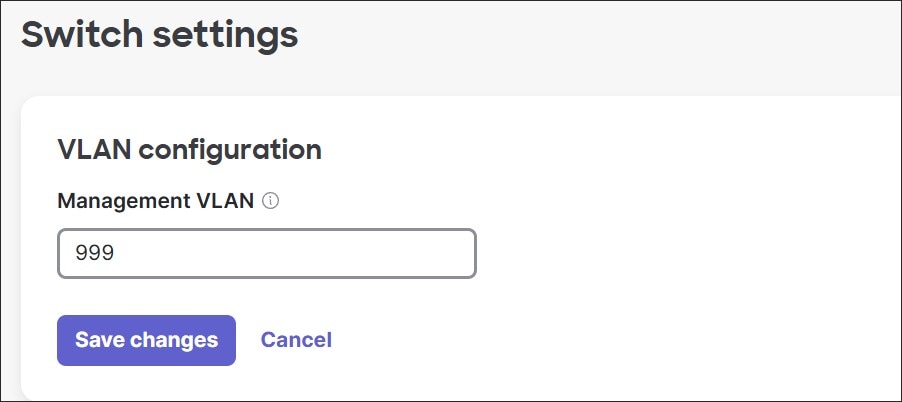
Once configured, go to Switching>Monitor>Switches, and select the switch to validate the changes.
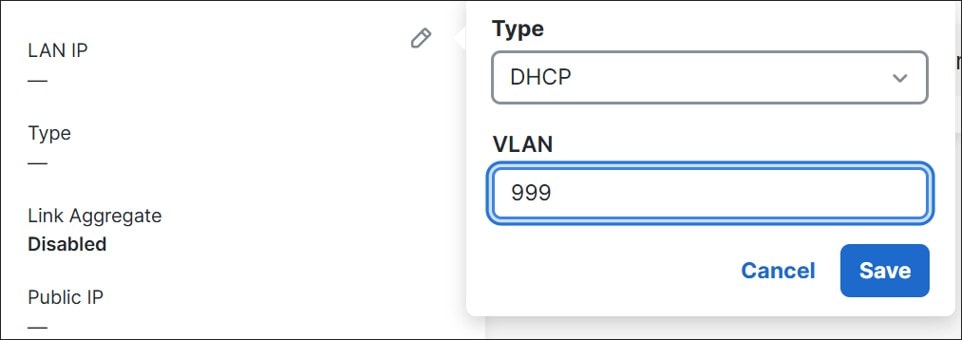
Wireless Access Point: Configure AP Management VLAN
Go to Wireless>Monitor>Access Points. Click the desired access point (named RTP6-Branch1-AP1). Click the edit symbol to the right of LAN IP. Fill in the VLAN (999) and click Save.

Once configured, go to Wireless>Monitor>Access Points, and select the access point to validate the changes.
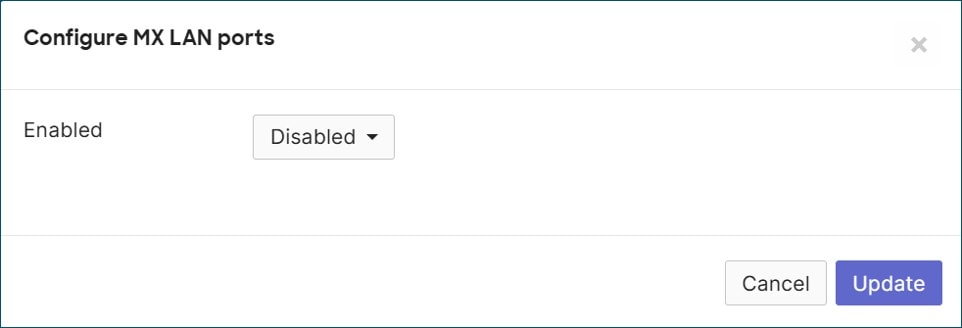
MX Router: Configure Ports
By default, all LAN ports are configured as 802.1Q trunk ports with VLAN 1 as the native/untagged VLAN. Go to Security & SD-WAN>Configure>Addressing & VLANs>Routing and under Per-port VLAN Settings, disable all unused ports (currently, only LAN port 5 is in use for the downstream switch). Click the checkbox to the left of port 6 and hold the shift button while clicking the checkbox to the left of port 14 to select the rest of the ports, then click Edit. Select Disabled from the drop-down box, then click Update.
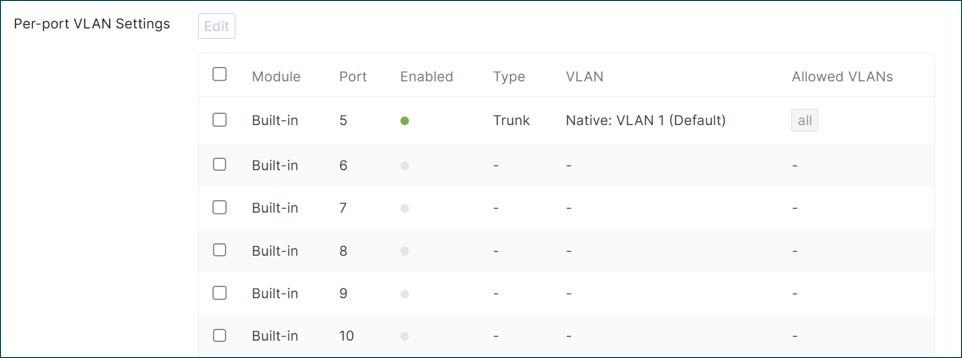
Click Save.
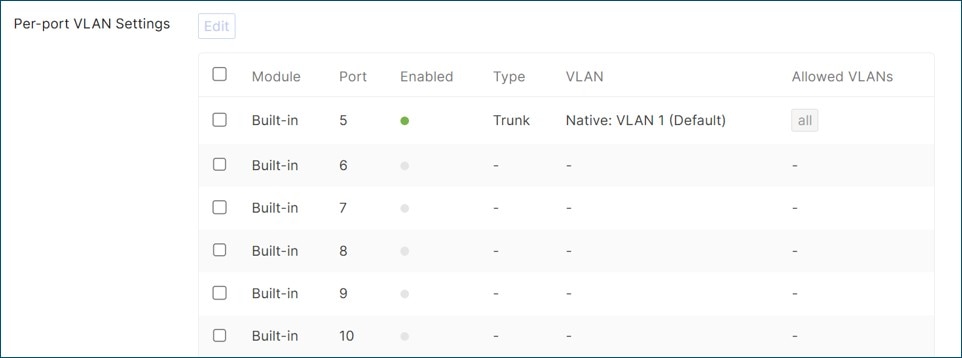
Switch: Configure Ports
To apply the port profile configurations to the switch ports, go to Switching>Monitor>Switch Ports. Port 1 is the uplink to the MX router in our example and will remain at defaults. Click the port definition to the left of uplink details. The default settings are shown as follows:
● Port Status: Enabled
● Link negotiation: Auto negotiate
● Port schedule: Unscheduled
● Type: Trunk
◦ Access policy: Open
◦ Native VLAN: 1
◦ Allowed VLANs: all
● RSTP: Enabled
● STP guard: Disabled
● Port isolation: Disabled
● Trusted DAI: Disabled
● UDLD: Alert only
● PoE: Enabled
● Storm control: Disabled
Create a Name for the port. In this example, the name is set to Uplink to MX-Primary. Click Update.
![]()
In this example, Port 9 of the switch is connected to the access point. Click the port definition to the left of details. Configure the Name (Link to AP1) and select the Port profile name (AP-Profile). Click Update.
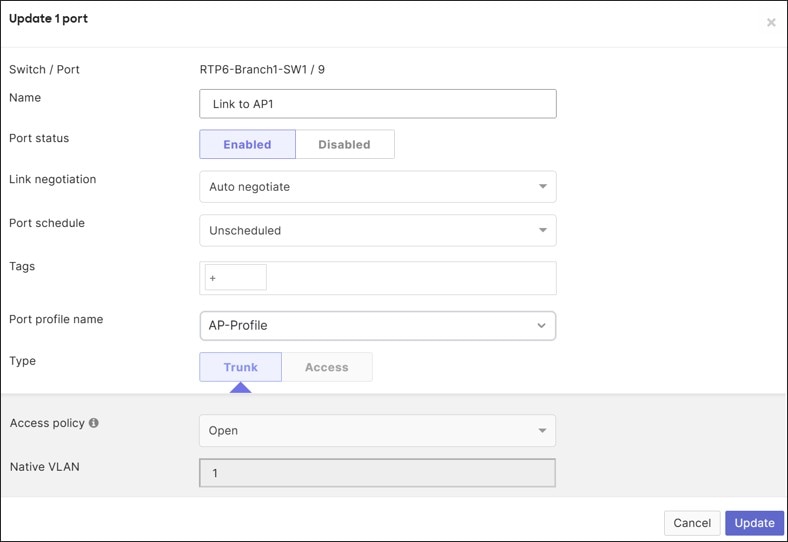
For the rest of the ports (ports 2-8, 10-28), select the check box to the left and click Edit at the top of the screen. Fill out an optional Name (Access Port) and select the Port profile name (Data-Profile). Click Update.
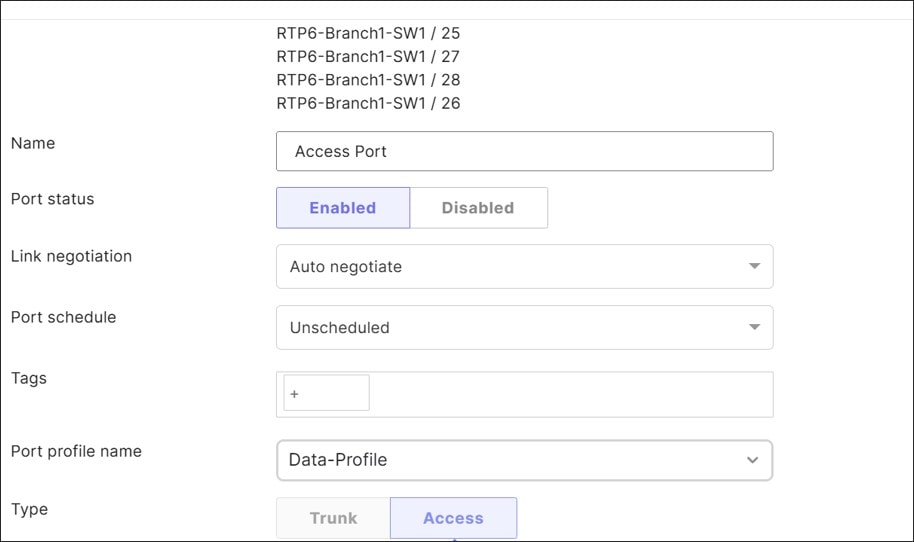
Appendix A: Example Deployment Settings
The following summarizes the configurations used in this example deployment. If a setting is not mentioned, the default has been taken. Some of the values below may reflect default values.
Organization Settings
Under Organization>Configure on the Dashboard
| Main Menu |
Section |
Subsection |
Values |
| Settings |
SNMP |
Version 2C Version 3 Authentication mode Authentication password Privacy mode Privacy password IP restrictions |
SNMP V2C disable SNMP V3 enabled SHA <passphrase> AES128 <passphrase> <IP address> |
| Policy Objects |
All objects |
Corp SNMP Corp DNS-DHCP Corp Mgt Corp Radius |
10.102.1.161 10.102.1.160 10.102.1.160 10.102.1.157 |
| Policy Objects |
All objects |
Guest Subnet Infra Subnet IOT Subnet Voice Subnet Data Subnet |
172.16.99.0/24 10.250.0.0/16 10.30.0.0/16 10.20.0.0/16 10.10.0.0/16 |
| Policy Objects |
All objects |
Branch 1 Printer 1 Branch 1 Printer 2 |
10.30.1.101 10.30.1.102 |
| Policy Objects |
Groups |
Corp Shared Services Branch 1 Printers |
Corp DNS-DHCP, CORP Radius, Corp Mgt, Corp SNMP Branch 1 Printer 1, Branch 2 Printer 2 |
Network-wide Settings
Under Network-wide>Configure on the Dashboard
| Main Menu |
Section |
Subsection |
Values |
| General |
General |
Network name |
RTP-Branch1 |
| General |
General |
Local time zone |
America – New York (UTC -4.0, DST) |
| General |
Reporting |
Syslog servers |
10.102.1.160, port 514, Roles Air Marshal events, Appliance event log, Flows, Security events, Switch event log, URLs, Wireless event log |
| General |
Reporting |
SNMP access SNMP users Privacy Mode |
V3 (username/passwords) snmpuser, <passphrase>, privacy = AES128 |
| General |
Reporting |
Network traffic reporting NetFlow collector IP NetFlow collector port |
Enabled: send netflow traffic statistics 10.102.1.160 2055 |
| Alerts |
Alerts Settings |
Default recipients |
snmp |
| Alerts |
Alerts Settings |
Network-wide WAN appliance |
Network-wide: A rogue access point is detected WAN appliance: Malware is downloaded |
| Alerts |
SNMP traps |
Access Users Receiving server IP Receiving server port |
V3 (username/password) snmpuser, <passphrase> <IP address> 162 |
| Group policies |
Employees |
Wireless only/VLAN |
Tag VLAN 10 |
| Group policies |
Voice |
Wireless only/VLAN |
Tag VLAN 20 |
| Group policies |
IOT |
Wireless only/VLAN |
Tag VLAN 30 |
MX Router Settings
Under Security & SD-WAN>Configure on the Dashboard
| Section |
Subsection |
Values |
|
| Site-to-site VPN |
Site-to-site VPN |
Type |
Spoke |
| Site-to-site VPN |
Site-to-site VPN |
Hubs |
RTP6-DC1 – appliance, IPv4 default route enabled RTP6-DC2 – appliance, IPv4 default route enabled |
| Addressing & VLANs |
Deployment Settings |
Mode |
Routed |
| Addressing & VLANs |
Routing |
LAN Setting |
VLANs |
| Addressing & VLANs |
Routing |
Subnets |
● 999, INFRA, 10.250.1.1/24, VPN mode = Enabled
● 50, GUEST, 172.16.99.1/24, VPN mode = Disabled
● 30, IOT, 10.30.1.1/24, VPN mode = Enabled
● 20, VOICE, 10.20.1.1/24, VPN mode = Enabled
● 10, DATA, 10.10.1.1/24, VPN mode = Enabled
● 1, Default, 192.168.128.1/24, VPN mode = Disabled
|
| Addressing & VLANs |
Routing |
Per-port VLAN Settings |
● Port 5 Enabled, Type Trunk, Native VLAN 1, Allowed VLANs = All
● Ports 6-14 Disabled
|
| DHCP |
VLAN 1 (Default) |
Client addressing Mandatory DHCP DNS nameservers |
Run a DHCP server Enabled Use OpenDNS |
| DHCP |
VLAN 10 (DATA) |
Client addressing DHCP server IPs Mandatory DHCP |
Relay DHCP to another server 10.102.1.160 10.102.1.161 Disabled |
| DHCP |
VLAN 20 (VOICE) |
Client addressing DHCP server IPs Mandatory DHCP |
Relay DHCP to another server 10.102.1.160 10.102.1.161 Disabled |
| DHCP |
VLAN 30 (IOT) |
Client addressing DHCP server IPs Mandatory DHCP |
Relay DHCP to another server 10.102.1.160 10.102.1.161 Disabled |
| DHCP |
VLAN 50 (GUEST) |
Client addressing Mandatory DHCP DNS nameservers |
Run a DHCP server Enabled Use OpenDNS |
| DHCP |
VLAN 999 (INFRA) |
Client addressing Mandatory DHCP DNS nameservers Custom nameservers Fixed IP assignments |
Run a DHCP server Disabled Specify nameservers 10.102.1.160 10.102.1.161 RTP-Branch1-SW1, 6c:c3:b2:7e:se:0a, 10.250.1.11 RTP-Branch1-AP1, cc:6e:2a:dd:f8:c0, 10.250.1.12 |
| Site-to-site VPN |
Organization-wide settings |
Site-to-site outbound firewall |
● Shared Services: Allow prot:Any Src:[Data Subnet, IOT Subnet, Voice Subnet, Infra Subnet] Any Dest:Corp Shared Services Any
● Shared Services: Allow prot:Any Src:Corp Shared Services Any Dest:[Data Subnet, IOT Subnet, Voice Subnet, Infra Subnet] Any
● Data Access: Deny prot:Any Src:Data Subnet Any Dest:[IOT Subnet, Voice Subnet, Infra Subnet] Any
● IOT Access: Deny prot:Any Src:IOT Subnet Any Dest:[Data Subnet, Infra Subnet, Voice Subnet] Any
● Infra Access: Deny prot:Any Src:Infra Subnet Any Dest:[Data Subnet, IOT Subnet, Voice Subnet] Any
● Voice Access: Deny prot:Any Src:Voice Subnet Any Dest:[IOT Subnet, Infra Subnet, Data Subnet] Any
● Default rule: Allow prot:Any Src:Any Any Dest:Any Any
|
| Firewall |
Layer 3 |
Outbound rules |
● Local Print Access: Allow prot:Any Src:[DATA VLAN] Any Dest:[Branch 1 Printers] Any
● Allow DIA: Allow prot:Any Src:[INFRA VLAN, DATA VLAN, GUEST VLAN, Default VLAN] Any Dest:Any Any
● Deny All: Deny prot:Any Src:Any Any Dest: Any Any
● Default Rule: Allow prot:Any Src: Any Any Dest: Any Any
|
| Firewall |
Layer 3 |
WAN appliance services |
ICMP Any, Web None, SNMP None |
| SD-WAN & traffic shaping |
Uplink configuration |
WAN 1 |
400 Mbps |
| SD-WAN & traffic shaping |
Uplink configuration |
WAN 2 |
500 up/500 down |
| SD-WAN & traffic shaping |
Uplink selection |
Load balancing |
Disabled |
| SD-WAN & traffic shaping |
Uplink selection |
Multi-Uplink AutoVPN |
Enabled |
| SD-WAN & traffic shaping |
SD-WAN policies |
Internet traffic |
● Prefer WAN 2. Fail over if uplink down
● 10.250.1.0/24:any to any:any
|
| SD-WAN & traffic shaping |
SD-WAN policies |
Internet traffic |
● Prefer WAN 2. Fail over if poor performance for SaaS_Trafic
● 10.10.1.0/24 to Office 365 or Webex
|
| SD-WAN & traffic shaping |
SD-WAN policies |
VPN traffic |
● Prefer WAN 2. Fail over if poor performance for VoIP
● All VoIP & Video conferencing
|
| SD-WAN & traffic shaping |
SD-WAN policies |
VPN traffic |
● Prefer WAN 2. Fail over if poor performance for “Critical_Apps”
● TCP from Any to 10.102.1.161/32:443
|
| SD-WAN & traffic shaping |
SD-WAN policies |
VPN traffic |
● Prefer WAN 1. Fail over if poor performance for “Default_SLA”
● Any to Any
|
| SD-WAN & traffic shaping |
SD-WAN policies |
Custom performance classes |
● SaaS_Traffic, 150, 50, 5
● Critical_Apps, 150, 20, 2
|
| SD-WAN & traffic shaping |
Local internet breakout |
VPN exclusion rules |
● Office 365 Suite
● Webex
● Layer 3 udp from Any to 64.62.142.12/32
● Layer 3 udp from Any to 158.115.128.0/19
● Layer 3 udp from Any to 209.206.48.0
● Layer 3 udp from Any to 216.157.128.0/20
|
| SD-WAN & traffic shaping |
Global bandwidth limits |
Per-client limit |
unlimited |
| SD-WAN & traffic shaping |
Traffic shaping rules |
Default Rules |
Enable default traffic shaping rules |
| SD-WAN & traffic shaping |
Traffic shaping rules |
Rule #1 |
● Definition: localnet 172.16.99.0/24
● Bandwidth limit: Ignore network per-client limit (unlimited)
● Priority: Low
● DSCP tagging: 0 (CS0/DF – Best Effort/Default Forwarding)
|
| SD-WAN & traffic shaping |
Traffic shaping rules |
Rule #2 |
● Definition: net/port 10.102.1.161/32
● Bandwidth limit: Ignore network per-client limit (unlimited)
● Priority: High
● DSCP tagging: 18 (AF21 – Low Latency Data, Low Drop)
|
| Threat Protection |
Advanced Malware Protection (AMP) |
Mode |
Enabled |
| Threat Protection |
Intrusion detection and prevention |
Mode Ruleset |
Prevention Balanced |
| Content Filtering |
Category blocking |
Content categories |
Adult, Hate Speech, Illegal Activities, Illegal Drugs, Pornography, Child Abuse Content, Illegal Downloads, Terrorism and Violent Extremism |
| Content Filtering |
Category blocking |
Threat categories |
Malware Sites, Spyware and Adware, Phishing, Botnets, Spam, Exploits, High Risk Sites and Locations, Bogon, Ebanking Fraud, Indicators of Compromise (IOC), Malicious Sites, Cryptojacking, Newly Seen Domains, Domain Generated Algorithm, Open HTTP Proxy, Open Mail Relay, TOR exit Nodes, Linkshare |
| Content Filtering |
URL filtering |
Blocked URL list |
www.example.com |
Under Security & SD-WAN>Monitor on the Dashboard
| Main Menu |
Section |
Subsection |
Values |
| Appliance Status |
Summary |
Appliance name (top left, edit mac address) |
RTP6-Branch1-MX |
Switch Settings
Under Switching>Configure> on the Dashboard
| Main Menu |
Section |
Subsection |
Values |
| Switch Settings |
Switch settings |
VLAN configuration |
999 |
| Switch Settings |
Switch settings |
STP configuration |
Enable Rapid Spanning Tree (RSTP): Enabled STP bridge priority: Switches/Stacks (RTP6-Branch1-SW1) STP bridge priority: Bridge priority (4096) |
| Switch Settings |
Switch settings |
Quality of service |
VLAN: 50, Trust: Disabled, Set DSCP: 0 VLAN 10, Trust: Enabled VLAN 20, Trust: Enabled VLAN 30, Trust: Enabled |
| Switch Settings |
Switch settings |
Storm control |
● Broadcast, 20%
● Multicast, 10%
● Unknown Unicast, 10%
|
| Access Policies |
Access Policies |
Name Authentication method Radius servers Radius servers Radius servers Connection Options |
Radius-MAB Radius server RADIUS Server testing RADIUS CoA support enabled Host 10.102.1.157, secret <secret>, Auth enabled, Port 1812 Hybrid authentication, Single-Host, Both Voice auth enabled |
| Port Profiles |
Port Profiles |
Profile name: Data-Profile |
● Type: Access
● Access policy: Radius-MAB
● VLAN: 10
● Voice VLAN: 20
● RSTP: Enabled
● STP guard: BPDU guard
● UDLD: Alert only
● PoE: Enabled
● Storm control: Enabled
|
| Port Profiles |
Port Profiles |
Profile name: AP-Profile |
● Type: Trunk
◦ Native VLAN: 1 ◦ Allowed VLANs: 1-4094
● RSTP: Enabled
● STP guard: BPDU guard
● UDLD: Alert only
● PoE: Enabled
● Storm control: Disabled
|
Under Switching>Monitor> on the Dashboard
| Main Menu |
Section |
Subsection |
Values |
| Switches (select switch) |
Summary |
Switch name (top left, edit mac address) |
RTP6-Branch1-SW1 |
| Switch Ports |
Switch Ports |
RTP-Branch1-SW1/1 - uplink |
● Name: Uplink to MX-Primary
● Type: Trunk
● Native VLAN: 1
● Allowed VLANs: all
● Access policy: Open
● RSTP: Enabled
● PoE: Enabled
● Storm control: Disabled
|
| Switch Settings |
Switch Ports |
RTP-Branch1-SW1/2-8, 10-28 |
Name: Access Port Port profile name: Data-Profile |
| Switch Settings |
Switch Ports |
RTP-Branch1-SW1/9 |
Name: Link to AP1 Port profile name: AP-Profile |
Access Point Settings
Under Wireless>Configure> on the Dashboard
| Main Menu |
Section |
Subsection |
Values |
| Access Control |
Basic info |
SSID (name) |
RTP6-BR1-GuestWiFi |
| Access Control |
Security (Guest) |
|
Open (no encryption) |
| Access Control |
Security (Guest) |
Mandatory DHCP |
Enabled |
| Access Control |
Splash page (Guest) |
|
Click-through |
| Access Control |
Client IP and VLAN (Guest) |
External DHCP server assigned |
Enabled/Bridged |
| Access Control |
Client IP and VLAN (Guest) |
VLAN tagging |
VLAN ID: Default AP tag, VLAN ID 50 |
| Access Control |
Basic info |
SSID (name) |
RTP-BR1-CorpWiFi |
| Access Control |
Security (Corp) |
|
Enterprise with my RADIUS server |
| Access Control |
Security (Corp) |
WPA encryption |
WPA3 Transition Mode |
| Access Control |
Security (Corp) |
802.11r |
Enabled |
| Access Control |
Security (Corp) |
802.11w |
Enabled (allow unsupported clients) |
| Access Control |
Security (Corp) |
Mandatory DHCP |
Enabled |
| Access Control |
Security (Corp) |
Advanced WPA3 settings |
WPA3 Cipher Suite: GCMP 256 enabled |
| Access Control |
Splash Page (Corp) |
|
None (direct access) |
| Access Control |
RADIUS (Corp) |
RADIUS servers |
10.102.1.157, 1812, <secret> |
| Access Control |
RADIUS (Corp) |
RADIUS accounting servers |
10.102.1.157, 1813, <secret> |
| Access Control |
RADIUS (Corp) |
RADIUS CoA support |
Disabled |
| Access Control |
RADIUS (Corp) |
RADIUS attribute specifying group policy name |
Filter-Id |
| Access Control |
Client IP and VLAN (Corp) |
External DHCP server assigned RADIUS override |
Enabled/Bridged Override VLAN tag |
| Access Control |
Client IP and VLAN (Corp) |
VLAN tagging |
VLAN ID: Default AP tag, VLAN ID 10 |
| Firewall & traffic shaping |
Block IPs and ports (Guest) |
Layer 2 LAN isolation |
Enabled |
| Firewall & traffic shaping |
Block IPs and ports (Guest) |
Outbound rules |
● Deny IPv4 Any Local LAN Any Wireless clients access LAN
● Allow IPV4 Any Any Any Default rule
|
| Firewall & traffic shaping |
Traffic shaping rules (Guest) |
Per-client bandwidth limit Enable SpeedBurst Per-SSID bandwidth limit Shape traffic Default Rules |
50 Mbps Enabled 100 Mbps Shape traffic on this SSID Enable default traffic shaping rules |
| Firewall & traffic shaping |
Block IPs and ports (Corp) |
Outbound rules |
● Allow IPv4 Any Local LAN Any Wireless clients access LAN
● Allow IPV4 Any Any Any Default rule
|
| Firewall & traffic shaping |
Traffic shaping rules (Corp) |
Per-client bandwidth limit Per-SSID bandwidth limit Shape traffic Default Rules |
Unlimited Unlimited Shape traffic on this SSID Enable default traffic shaping rules |
| Splash page |
Splash page (Guest) |
Official themes |
Modern |
| Splash page |
Customize your page (Guest) |
Welcome message |
Click to continue if you agree to the terms of usage of this guest service. |
| Splash page
|
Splash behavior (Guest) |
Splash frequency Where should users go after the splash page? |
Every day The URL they were trying to fetch |
| SSID Availability |
SSID availability (all SSIDs) |
Visibility Per access point availability Scheduled availability Schedule templates |
Advertise this SSID publicly Enabled on all access points Enabled Custom schedule (Sun/Sat unavailable, M-F available 7:00-19:00) |
| Radio Settings |
RRM |
AI-RRM |
Enable |
| Radio Settings |
RF profiles (Indoor/Outdoor default) |
General/Band selection |
Per SSID |
| Radio Settings |
RF profiles (Indoor/Outdoor default) |
RTP6-BR1-CorpWiFi RTP6-BR1-GuestWiFi |
2.4/5/6/Band steering Enable 2.4/5 Enabled |
Under Wireless>Monitor> on the Dashboard
| Main Menu |
Section |
Subsection |
Values |
| Access Points |
Summary |
Access point name (top left, edit mac address) |
RTP6-Branch1-AP1 |
| Access Points |
RTP-Branch1-AP1 |
LAN IP (edit) |
VLAN 999 |
Appendix B: ISE Deployment Settings
The ISE deployment settings for the example deployment are documented in the following table:
| Main Menu |
Section |
Subsection |
Values |
| Administration |
Groups |
Endpoint Identity Groups |
MAB-IOT_Devices MAB-VOICE_Devices |
| Administration |
Groups |
User Identity Groups |
Employee |
| Policy |
Policy Elements/Results |
Authorization Profiles/Employee_VLAN |
● Access Type = ACCESS_ACCEPT
● Tunnel-Private-Group-ID = 1:10
● Tunnel-Type = 1:13
● Tunnel-Medium-Type = 1:6
|
| Policy |
Policy Elements/Results |
Authorization Profiles/Employee-GP |
● Access Type = ACCESS_ACCEPT
● Filter-ID = Employees
|
| Policy |
Policy Elements/Results |
Authorization Profiles/Voice_VLAN |
● Access Type = ACCESS_ACCEPT
● Tunnel-Private-Group-ID = 1:20
● Tunnel-Type = 1:13
● Tunnel-Medium-Type = 1:6
● cisco-av-pair = device-traffic-class=voice
|
| Policy |
Policy Elements/Results |
Authorization Profiles/Voice-GP |
● Access Type = ACCESS_ACCEPT
● Filter-ID = Voice
|
| Policy |
Policy Elements/Results |
Authorization Profiles/IOT_VLAN |
● Access Type = ACCESS_ACCEPT
● Tunnel-Private-Group-ID = 1:30
● Tunnel-Type = 1:13
● Tunnel-Medium-Type = 1:6
|
| Policy |
Policy Elements/Results |
Authorization Profiles/IOT-GP |
● Access Type = ACCESS_ACCEPT
● Filter-ID = IOT
|
| Policy |
Policy Sets (Wired Access) |
Conditions: Wired_802.1X or Wired_MAB |
● Authentication Policy:
◦ Wired_MAB (Internal Endpoints) ◦ Default (All_User_ID_Stores)
● Authorization Policy:
◦ IdentityGroup:Name = Endpoint Identity Groups:MAB-IOT_Devices or IdentityGroup:Name = User Identity Groups:IOT, Profile=IOT_VLAN ◦ IdentityGroup:Name = Endpoint Identity Groups:MAB-VOICE_Devices or IdentityGroup:Name = User Identity Groups:Voice, Profile=Voice_VLAN ◦ IdentityGroup:Name = Employee, Profile=Employee_VLAN |
| Policy |
Policy Sets (Wireless Access) |
Conditions: Wireless_802.1X |
● Authentication Policy:
◦ Default (All_User_ID_Stores)
● Authorization Policy:
◦ IdentityGroup:Name = User Identity Groups:IOT, Profile=IOT-GP ◦ IdentityGroup:Name = User Identity Groups:Voice, Profile=Voice-GP ◦ IdentityGroup:Name = User Identity Groups:Employee, Profile=Employee-GP |
Appendix C: Hardware and Software Versions Used
The following hardware and software versions were used in this example deployment:
| Hardware |
Software |
| MX85 |
MX 18.211.6 |
| MS150-24P-4G |
MS 17.2.1.1 |
| CW9172I |
MR 31.1.7.1 |
Appendix D: References
● Unified Branch Solution Brief
● Cisco Network as Code Website
● Branch as Code Github Repository
 Feedback
Feedback